AILET 2022 LLM Question paper with answer key pdf conducted on June 26 is available for download. The exam was successfully organized by Delhi National Law University. The question paper comprised a total of 110 questions divided among two sections.
AILET 2022 LLM Question Paper with Solution PDF
| AILET 2022 LLM Question Paper with Solution PDF | Check Solution |
Directions (Q.1 - Q. 8):
Each set of questions in this section is based on the passage. The questions are to be answered on the basis of what is stated or implied in the passage. Choose the most appropriate answer; that is, the response that most accurately and completely answers the questions.
It is undeniable that the Corona virus disease has taken the world by surprise. Governments radically forced guidelines that, in a matter of days, shut down businesses indefinitely and people found themselves compelled to abide by new norms. While the hygiene measures remained the same as for previous pandemics, the social distancing norms were particularly disruptive and made the experience unique.
To society, social distancing presents the dangers of increasing social rejection, growing impersonality and individualism, and the loss of a sense of community. It negatively affects learning and growth, and it prevents people from effectively socialising, which is a fundamental human need. First and foremost, the measures carried a strong psychological message, which is the fear of others, along with the idea that others are potential carriers of deadly germs and lifethreatening diseases. The alarming rate of contamination and death from the virus contributed to establishing more panic and even paranoia among many.
What is particularly concerning is the fact that this psychological effect could potentially remain in our communities, even long after the pandemic. Whether this is at work, in restaurants, or in public spaces, our society has long been characterised by physical interactions between people. We are used to working in groups, going places, meeting new people, and making conversations with them on a daily basis. As we navigate through life, much of what fulfills us are the bonds we create with other people, and more often than not, those bonds materialise through physical interactions. Indeed, feeling insufficiently connected to others is associated with profound and lasting negative consequences on physical and mental health, even leading to increased mortality.
Physical interactions are an essential part of human social experience, and they are particularly important for the social development of young people. Indeed, young people flourish socially through connections and fulfilling relationships, which are also an integral part of their learning. By closing schools, the pandemic has prevented many children and adolescents from socialising with others. This has affected their ability to make quality connections, which impacts their personal growth. Long-term isolation leaves these basic human needs unsatisfied and ultimately affects mental health.
Question 1:
The uniqueness of the experience referred to in paragraph 1 primarily refers to
The passage indicates that social distancing norms
View Solution
Step 1: Understanding the Question
The question asks for the passage's overall assessment of social distancing norms.
Step 2: Detailed Explanation
The passage consistently describes the negative effects of social distancing.
Paragraph 2 states it presents "dangers of increasing social rejection, growing impersonality and individualism, and the loss of a sense of community." and "negatively affects learning and growth".
Paragraph 3 mentions the "profound and lasting negative consequences on physical and mental health".
Paragraph 4 highlights how it "affected their ability to make quality connections, which impacts their personal growth" and ultimately "affects mental health".
These points collectively show a significant detrimental impact. Therefore, option (A) is the most accurate summary.
Option (B) is not stated in the passage. While it might be the reason for the norms, the passage focuses on the consequences, not the justification.
Option (C) is explicitly contradicted in the first paragraph: "While the hygiene measures remained the same... the social distancing norms were particularly disruptive".
Option (D) is incorrect; the passage argues that they harmed social and mental well-being.
Step 3: Final Answer
The passage focuses almost entirely on the negative psychological and social consequences of social distancing. Thus, it had an overall detrimental impact on people. Option (A) is the correct answer.
Quick Tip: Look for the overall tone and recurring themes in the passage. The author repeatedly uses negative language ("dangers," "negatively affects," "negative consequences") to describe social distancing, which points to a detrimental impact.
According to the passage, the core need of a human being is
View Solution
Step 1: Understanding the Question
The question asks to identify the "core need of a human being" as described in the passage.
Step 2: Detailed Explanation
This is a tricky question based on the provided answer key. The passage explicitly states in paragraph 2 that "effectively socialising... is a fundamental human need". This would logically point towards an answer related to socializing.
However, the provided answer is (C). To justify this, we must interpret the passage's context differently.
The passage opens by describing how "Governments radically forced guidelines" and "people found themselves compelled to abide by new norms."
In the context of a life-threatening pandemic, the passage describes a situation where survival depends on following these rules. The psychological message was the "fear of others" and "deadly germs," which triggers a powerful drive for self-preservation (D). Adherence to government directives (C) becomes the primary means to achieve this self-preservation.
While socializing is a "fundamental" need in a normal context, the passage portrays a crisis where this need is overridden by the more urgent, imposed "need" to adhere to directives for survival. The compulsion to abide becomes a de facto core concern for well-being in this specific, unprecedented situation.
Step 3: Final Answer
Although the passage directly names socializing as a fundamental need, the context of government compulsion and the threat of the virus elevates adherence to directives to a primary necessity for survival, making option (C) a contextually plausible, albeit counter-intuitive, answer as per the key.
Quick Tip: Some questions in competitive exams can be ambiguous or have answers that rely on interpreting the immediate context over general statements. When a direct statement in the text seems to contradict the answer key, look for contextual clues or a shift in focus within the passage that could justify the given answer.
Mankind finds its greatest fulfilment in
View Solution
Step 1: Understanding the Question
The question asks what, according to the passage, brings the greatest fulfillment to mankind.
Step 2: Detailed Explanation
Paragraph 3 provides a clear answer. It states, "As we navigate through life, much of what fulfills us are the bonds we create with other people, and more often than not, those bonds materialise through physical interactions.".
This sentence directly links fulfillment to the "bonds we create with other people" and emphasizes that these bonds are often formed through "physical interactions".
Option (B) "The deep relationships forged by physical interaction" is a precise summary of this statement.
Option (A) is not mentioned in the passage as a source of fulfillment.
Option (C) is a part of forming relationships, but the passage emphasizes the deeper "bonds" and "relationships" as the source of fulfillment, not just casual conversations.
Option (D) is a goal for survival, not a source of fulfillment described in the passage.
Step 3: Final Answer
The passage explicitly states that fulfillment comes from the bonds and relationships created with others, which are materialized through physical interaction. Therefore, option (B) is the correct answer.
Quick Tip: For questions using words like "greatest," "primary," or "main," look for definitive statements in the passage. Phrases like "much of what fulfills us" or "first and foremost" are strong indicators of the author's main point.
Which of the following statements best describe the relationship between the first and the final paragraph ?
View Solution
Step 1: Understanding the Question
The question asks to define the logical connection between the first and the last paragraphs of the passage.
Step 2: Detailed Explanation
The first paragraph introduces the issue: the "particularly disruptive" and "unique" nature of social distancing norms during the pandemic. This sets up a tone of concern about its impact.
The final paragraph elaborates on this concern by focusing on a specific, vulnerable group: young people. It explains how school closures and lack of socialization affect their "social development," "personal growth," and "mental health." This provides concrete examples and deepens the initial concern.
Therefore, the first paragraph raises a general concern, and the final paragraph provides specific evidence and examples (substantiates) to support and strengthen that concern.
Option (A) accurately describes this relationship.
Option (B) is similar, but "substantiates the idea" is more precise than "sums up the challenges." The final paragraph doesn't just list challenges; it explains the mechanism of the damage, thereby substantiating the initial worry.
Option (C) is incorrect as the final paragraph supports, not contradicts, the first.
Option (D) is incorrect as the paragraphs are clearly linked by the central theme of social distancing's negative impact.
Step 3: Final Answer
The final paragraph provides specific details about the negative impact on youth, which serves to prove and give weight to the general concern about disruptive social distancing introduced in the first paragraph. Thus, option (A) is the best description.
Quick Tip: When analyzing the relationship between paragraphs, first identify the main idea of each paragraph. Then, see how they connect. Do they show cause and effect, problem and solution, general idea and specific example, or a contradiction? This will help you choose the correct option.
The phrase "navigate through life" in paragraph 3 implies
View Solution
Step 1: Understanding the Question
The question asks for the meaning of the idiomatic phrase "navigate through life" as used in the passage.
Step 2: Detailed Explanation
The phrase "navigate through life" is a metaphor. To "navigate" means to plan and direct a route or course. In the context of life, it refers to the process of making one's way through various experiences, challenges, and stages. It implies managing the journey of life.
"Finding a direction" (C) best captures this essence of guiding oneself through the complexities of life.
"Reaching milestones" (A) and "Accomplishing goals" (B) are specific events within the journey of life, but "navigating" refers to the entire process of moving forward, not just the destinations.
"Enduring trauma" (D) is too specific and negative; navigating life includes positive experiences as well.
The sentence says, "As we navigate through life, much of what fulfills us are the bonds we create..." This suggests the journey itself, and finding one's way and purpose within it.
Step 3: Final Answer
The phrase "navigate through life" metaphorically means to find one's way or direction through the course of life. Option (C) is the most fitting interpretation.
Quick Tip: When faced with an idiomatic phrase, consider its literal meaning first (e.g., navigating a ship) and then think about how that meaning is applied metaphorically to the subject (e.g., life). This can help you understand the intended meaning.
What long term psychological impact is the author concerned about ?
View Solution
Step 1: Understanding the Question
The question asks about the specific long-term psychological concern the author highlights in the passage.
Step 2: Detailed Explanation
The passage expresses concern about a psychological effect that "could potentially remain in our communities, even long after the pandemic" (Paragraph 3).
The end of Paragraph 3 explicitly details the severity of this impact: "Indeed, feeling insufficiently connected to others is associated with profound and lasting negative consequences on physical and mental health, even leading to increased mortality.".
This statement directly matches option (D). The words "devastating impact" correspond to "profound and lasting negative consequences," and "prove fatal" corresponds to "leading to increased mortality".
Option (A) is a possible outcome, but (D) describes the consequence of that isolation, which is the author's primary concern.
Option (B) is an exaggeration; the passage says development is "affected" and "impacted," not that it will be "stunted" for all young people.
Option (C) describes the cause of the problem (fear of others), but (D) describes the ultimate, most severe impact of that problem (disconnection leading to health issues and death), which is the author's deepest concern.
Step 3: Final Answer
The author's most grave long-term concern is that the feeling of disconnection will lead to severe health consequences, including death. Option (D) accurately reflects this.
Quick Tip: Look for the strongest and most conclusive language used by the author to identify their main concern. Phrases like "profound and lasting negative consequences" and "even leading to increased mortality" signal the most serious point being made.
Which one of the following statements most accurately expresses the main point of the passage ?
View Solution
Step 1: Understanding the Question
The question asks for the main point or central thesis of the entire passage. A good summary should encompass the key ideas presented.
Step 2: Detailed Explanation
The passage discusses the disruptive nature of social distancing (Paragraph 1), its negative psychological and social effects on the community (Paragraphs 2 & 3), and its specific, damaging impact on the development and mental health of young people (Paragraph 4).
Option (A) effectively summarizes these points. It acknowledges the context (containing the pandemic) while focusing on the passage's main argument: the "damaging impact on the social interaction," with a special mention of the youth, who are the focus of the final paragraph.
Option (B) makes a claim ("followed more rigorously than before") that is not explicitly stated in the passage.
Option (C) is not supported by the passage; the text focuses on the prevention of interaction, not on overcoming it.
Option (D) presents a value judgment or a policy recommendation ("It is better to...") that the author does not explicitly make. The author analyzes the negative effects but does not propose a solution or weigh physical vs. mental health in this manner.
Step 3: Final Answer
Option (A) provides the most balanced and comprehensive summary of the author's argument throughout the passage, addressing both the context and the specific negative consequences highlighted.
Quick Tip: To find the main point of a passage, look for a statement that synthesizes the ideas from the beginning, middle, and end. The correct answer will be a summary of the author's overall argument, not just a detail from one paragraph.
II. Directions (Q. 9 - Q. 15): Each question has a word followed by four choices. Select the word which is most similar in meaning to the given word.
Question 9:
Palliative
Agog
Gullible
Inure
Percipient
Unanimous
Fatigue
III. Directions (Q. 16 - Q. 22): Each question has a word followed by four choices. Select the suitable antonym.
Question 16:
Cogitate
Reverent
Punctilious
Insouciant
Ossify
Judicious
Deride
IV. Directions (Q. 23 - Q. 29): Choose the best word to fill in the blanks.
Question 23:
"Not to worry our key witness has an ________ memory", the lawyer said.
The actor's Oscar acceptance speech came off as 45 seconds of unabashed ________.
During lunch breaks, Sharad's co-workers invariably would listen to him ________ over him having left his village.
The Army along with the ________ factory has developed an indigenous system for lifting the 105 mm Light Field Gun (LFG) and hopes to bag a bulk production order.
To prevent poisoning accidents among children, parents ________ medications in a locked cabinet.
A ________ displays academic learning and is excessively concerned with minor details and rules.
People who are ________ about their jobs will not take their work seriously.
V. Directions (Q. 30 - Q. 36): Choose the option which best expresses the meaning of the idiom/phrases underlined in the given sentences.
Question 30:
The instructors at the camp were well-equipped to handle first time trekkers who could go green around the gills.
Harry Kumar was named the best new director of 2010 but his career was a flash in the pan.
After the heart attack, Suresh's decision to go cold turkey with smoking backfired.
Without doubt, it is the leadership whom we naturally call on the carpet first for anything untowards that happens.
The Municipal Council wants residents to pony up for overstaying their lease period.
Asking your grandmother to sell her ancestral home is like beating a dead horse.
The new marketing campaign is not a patch on our classic old ads.
VI. Directions (Q. 37 - Q. 43): Choose the grammatically correct option for each of the following sentences.
Question 37:
Choose the grammatically correct option.
Choose the grammatically correct option.
Choose the grammatically correct option.
Choose the grammatically correct option.
Choose the grammatically correct option.
Choose the grammatically correct option.
Choose the grammatically correct option.
VII. Directions (Q. 44 - Q. 50): Choose the option which best expresses the meaning of the foreign expression given below.
Question 44:
Ad infinitum
Ipso facto
Sine die
Status quo
Carte Blanche
Ex gratia
Amicus Curiae
Direction: Certain legal principles and specific factual situations are provided in each of the following questions. Apply the principles to the given facts and select the most appropriate answer.
Question 51:
LEGAL PRINCIPLE : A statement is defamatory in nature if it is injurious to a person's reputation and if the statement has been published.
FACTUAL SITUATION : Aneesh had been dating a girl named Amita for three weeks. But he had introduced himself to her as Amay Thakur (who is one of Amita's friends) and he continued to be Amay for the rest of their relationship. But ultimately the relationship ended badly and Amita being upset and angry at Aneesh started a website named 'Amay-thakur-is-a-jerk.com'. She created this website so as to warn other girls about Amay Thakur. The real Amay Thakur files a suit for defamation. Decide.
DECISION:
LEGAL PRINCIPLE : Whoever dishonestly misappropriates or converts to his own use any moveable property is guilty of criminal misappropriation of property.
FACTUAL SITUATION : X finds a government note belonging to Y, bearing a blank endorsement. X knowing that the note belongs to Y, pledges it with a banker as a security for loan, intending to restore it to Y at a future time. Has X committed criminal misappropriation ?
DECISION:
LEGAL PRINCIPLE: A master shall be liable for the acts of his servants done in the course of employment.
FACTUAL SITUATION: PAL, a public sector undertaking, is operating a number of bus services for its employees in Pune. These buses are quite distinct in their appearance and carry the board 'for PAL employees only'. M, a villager from neighboring state, was waiting for a regular bus in one of the bus stops in Pune. A bus belonging to PAL happened to stop nearby and number of people got into the bus. M, without realizing that it was PAL bus, got into the bus and soon thereafter, the bus met with an accident due to driver's negligence. M, along with several others, was injured in the accident. M seeks to file a suit against PAL claiming damages.
DECISION:
LEGAL PRINCIPLE :
1. Offer is a proposal made by one person to another to do an act or abstain from doing it. The person who makes the offer is known as the promisor or offeror and the person to whom an offer is made is known as the promisee or the offeree.
2. A contract comes into being by the acceptance of an offer. When the person to whom the offer is made signifies his consent thereto, the proposal is said to be accepted and the parties are at consensus ad idem regarding the terms of the agreement.
FACTUAL SITUATION: In Dec. 2019, a convicted murderer who was sentenced to death escaped from the custody of Mukesh, a prison official. Mukesh later offered a reward of INR 50,000 to anyone who captured the fugitive and returned him to the authorities. In Jan. 2020, without knowledge or notice of the reward, Rohan captured the fugitive and took him to Mukesh's jail house. Mukesh refused Rohan's demands for the reward money. Rohan filed a case against Mukesh to recover the reward. Mukesh alleges that there is no contract between Mukesh and Rohan.
LEGAL PRINCIPLE : When one person signifies to another his willingness to do or abstain from doing anything, with a view to obtaining the assent of that person to such an act or abstinence, he is said to have made a proposal.
FACTUAL SITUATION : Mohan sends a telegram to Sohan, writing: "Will you sell me your Rolls Royce car? Telegram the lowest cash price." Sohan also replied by telegram: "Lowest price for car Rs. 20 lakh." Mohan immediately sent his consent through telegram stating: "I agree to buy the car for Rs. 20 lakh asked by you." Sohan refused to sell the car.
DECISION :
LEGAL PRINCIPLE: A person is said to be of sound mind for the purpose of making a contract if, at the time when he makes it, he is capable of understanding it and of forming a rational judgement as to its effect upon his interests.
FACTUAL SITUATION : Mr. Xiu who is actually of sound state of mind, but occasionally of unsound state of mind, enters into a contract with Mr. Yan when he was of unsound state of mind. Mr. Yan having come to know about this fact afterwards wants to file a suit against Mr. Xiu.
DECISION :
LEGAL PRINCIPLE : Ignorance of fact is excused but ignorance of law is not an excuse to criminal liability.
FACTUAL SITUATION : Abhay was a passenger from Frankfurt to Jakarta on a Lufthansa plane. When the plane landed at the Mumbai Airport on 24 November 2021 it was found on searching that Abhay carried 34 kg of gold bars on his person and that he had not declared it in the 'Manifest of Transit'. On 22 November 2021, the Government of India had issued a notification modifying its earlier exemption, making it mandatory that gold must be declared in the "Manifest" of the aircraft.
DECISION :
LEGAL PRINCIPLE: Any direct physical interference with goods in somebody's possession without lawful justification is called trespass of goods.
FACTUAL SITUATION: Z purchased a car from a person who had no title to it and sent it to garage for repair. X believing wrongly that the car was his, removed it from the garage. Has he committed any offence ?
DECISION:
LEGAL PRINCIPLE : No confession made to a Police Officer, shall be proved as against a person accused of any offence.
FACTUAL SITUATION : Thanu was accused of having murdered Vinu over a property dispute. After arrest, Thanu made a confession to the Inspector that she had in fact murdered Vinu. The confessional statement of Thanu was written on a paper and Thanu signed the same. The police carried on further investigation but were not able to find any other evidence to produce before the court. Can the confessional statement signed by Thanu be proved in court ?
DECISION :
LEGAL PRINCIPLE : Whoever dishonestly takes away any property from the possession of another, with an intention of such taking away, without his permission is liable for theft.
FACTUAL SITUATION : Raja, a famous gangster, moves into an apartment in Kankurgachi, Calcutta. There, he discovers that the previous owner of the apartment had left behind a pair of beautiful ivory handled combs. Mesmerized by their beauty and confused as to whom he should be returning them to, he decides to retain them and starts using them. The previous owner of the combs gets to know this and registers an FIR for theft against Raja. Is Raja liable ?
DECISION :
LEGAL PRINCIPLE : The state shall make special laws for the upliftment of citizens of the country, and these laws can be made for the benefit of any specific caste, class or sex of people living in the society.
FACTUAL SITUATION : The state of Hindu Pradesh comes out with a law, which provided for reservation to Muslims in all government and government aided institutions. This law is challenged in the High Court of Hindu Pradesh, as being arbitrary and contrary to the established laws. Can the challenge be successful ?
LEGAL PRINCIPLE : The master/principal is liable for all acts done by his duly appointed servant/agent for all acts done by him lawfully in the course of his employment.
FACTUAL SITUATION: A, B, C and D carried on a business in partnership. While making a deal with another company, B bribed the clerk there. Is the partnership firm vicariously liable ?
LEGAL PRINCIPLE: A contract which is impossible to perform becomes void.
FACTUAL SITUATION : Surender agreed to deliver specific quality of rice to Sonakshi identified by both of them. Before delivery, the rice was burnt by short circuit. Is Surender discharged from the performance of the contract ?
LEGAL PRINCIPLE : Whoever stores a substance which could cause damage on escape shall be absolutely liable (i.e. liable even when he has exercised necessary care) for any damage caused by the escape of the substance.
FACTUAL SITUATION: Union Carbide India Limited (UCIL) manufactured methyl isocyanate, an extremely toxic gas. Due to a storm, the gas that was being stored in sealed containers got released. Before much could happen, the local municipal authorities managed to contain the disaster. The authorities filed a suit against UCIL for the costs that were incurred in decontamination. However, later it was realized that the clean-up by the authorities could have been done without spending as much resources and the damage was not that significant. UCIL argued that it would pay only part of the amount demanded by the authorities, which could have dealt with the contamination.
LEGAL PRINCIPLE: Nobody shall unlawfully interfere with a person's use or enjoyment of land, or some right over, or in connection with it. The use or employment, envisaged herein, should be normal and reasonable taking into account surrounding situation.
FACTUAL SITUATION: Jogi and Prakash were neighbors in a residential locality. Prakash started a typing class in a part of his house and his typing sound disturbed Jogi who could not put up with any kind of continuous noise. He files a suit against Prakash.
LEGAL PRINCIPLE :
1. Whoever causes death by doing an act with the intention of causing death or with the intention of causing such bodily injury as is likely to cause death or with the knowledge that he is likely by such act to cause death commits the offence of culpable homicide.
2. Mens rea and actus reus must concur to the result in a crime which is punishable by the law.
FACTUAL SITUATION : A and B went for shooting. A know Z to be behind a bush. B does not know it. A induces B to fire at the bush. B fires and kills Z. Has an offence been committed ?
DECISION :
LEGAL PRINCIPLE :
1. The crime of kidnapping involves taking someone away from the custody of their lawful guardian.
2. The crime of abduction involves inducing or forcing somebody to go away from some place against their will.
FACTUAL SITUATION: A steal B's slave. Is it a crime ?
Type of crime:
I. Kidnapping
II. Abduction
III. Neither
Reason:
A. Slavery is illegal.
B. A has taken him away from B's lawful custody.
C. A has forced somebody to go with him against his will.
DECISION :
LEGAL PRINCIPLE : Whoever delivers to another person as genuine any counterfeit currency which he knows to be counterfeit, but which that other person is not aware of at the time when he received it, is guilty of counterfeiting currency.
FACTUAL SITUATION : While returning home one day, Roshni realizes that the local shopkeeper has given her a fake note of Rs. 1,000. Disappointed, she goes to the same shop and buys cosmetics worth Rs. 600. She then passes the same fake note to the shopkeeper. The shopkeeper while inspecting the note finds out that it is fake. Is Roshni guilty ?
DECISION :
LEGAL PRINCIPLE :
1. To constitute a punishable criminal offence, guilty intention must accompany an illegal act.
2. Criminal mischief means causing damage to public property intentionally or with the knowledge that harm may occur.
FACTUAL SITUATION: Neel being a Shahrukh Khan fan went to the premier of the movie, Happy New Year. As usual, he carried his pen-knife, a gift from his dead mother. At the security check, impatient of waiting in the queue, Neel slunk past the guards and the metal detector when no one was watching. Later, he was apprehended in the hall and charged for mischief and possession of a weapon when it was expressly forbidden.
DECISION :
LEGAL PRINCIPLE : Only Parliament or State Legislatures have the authority to enact laws on their own. No law made by the State can take away a person's fundamental right.
FACTUAL SITUATION : Parliament enacted a law, which according to a group of lawyers is violating the fundamental rights of traders. A group of lawyers files a writ petition challenging the Constitutional validity of the statute seeking relief to quash the statute and further direct Parliament to enact a new law.
DECISION :
LEGAL PRINCIPLE : Necessity knows no law, and any person facing danger may do all that is necessary to avert the same till he can make recourse to public authorities.
FACTUAL SITUATION : Akshay, a law abiding citizen decided to remove the weed of corruption from Indian society. One day, confronted with a bribing official, Akshay decided to teach him a lesson and punched him on his face.
DECISION :
LEGAL PRINCIPLE :
1. Preparation to commit an offence is not an offence.
2. After one has finished preparation to commit an offence, any act done towards committing the offence with the intention to commit it, is an attempt to commit the offence which is by itself an offence.
FACTUAL SITUATION : A wanted to kill B and had therefore gone to the market to buy explosives to plant in his house. After A has planted the bomb, he felt guilty and he went back to remove the bomb but while he was doing so, B saw him and called the police. Can A be held liable ?
DECISION :
LEGAL PRINCIPLE: A reasonable classification having nexus with the object sought to be achieved is not violative of Article 14 or Article 16 of the Constitution of India.
FACTUAL SITUATION: 'X' is a male teacher in a women's college, who applied for the post of Principal of that college. His candidature was rejected on the basis of the Government policy of appointing only women as Principal of a women's college. 'X' challenges the policy on the ground of discrimination. Whether the challenge is sustainable ?
DECISION :
LEGAL PRINCIPLE: Any institution or body can be a 'State' if it is created under the Constitution or a statute; or if it is substantially financed by the Government; or the Government holds its share capital.
FACTUAL SITUATION: K approached the High Court by filing a writ petition against the Board for Control of Cricket in India (BCCI). The argument advanced was BCCI is a 'State' within the meaning of Article 12 of the Constitution of India. The question is whether the argument is acceptable ?
DECISION :
LEGAL PRINCIPLE : A suit shall be instituted in the court within whose jurisdiction the cause of action arises; or the defendant actually and voluntarily resides or carries on business, or personally works for gain.
FACTUAL SITUATION: 'Y' carries on business in Mumbai. 'Z' carries on business in Delhi. 'Z' buys goods of 'Y' in Mumbai through his agent and request 'Y' to deliver them at Delhi. Accordingly, 'Y' delivered the goods at Delhi. But he did not get the price of the goods delivered in Delhi. Therefore, he intends to move the Civil Court for recovery of amount of 'Z'. Which court may 'Y' approach ?
DECISION :
LEGAL PRINCIPLE : The acceptance of an offer will be valid only if it is made in the way it was expected to be made.
FACTUAL SITUATION : There was a telephonic discussion between 'J' and 'K' for negotiating the sale of the shop of former to the latter. Upon reaching an agreement as to the price of the shop of 'J' at Rs. 20 lakh, 'J' told 'K' to send a letter to him within two weeks confirming that she wishes to buy the shop for price finalized. Two days thereafter, 'K' gave her acceptance to 'J' over telephone but sent the letter of confirmation after lapse of one month. Is 'J' bound by acceptance of 'K' ?
DECISION :
LEGAL PRINCIPLE: A power conferred by a statute cannot be withdrawn by a subordinate legislation.
FACTUAL SITUATION : The Cinematograph Act conferred powers upon the District Magistrate (DM) to grant license subject to the control of the government. The government framed Rules under the said Act. The effect of these Rules was that the licensing power stood transferred to the Government itself and the District Magistrate was rendered powerless. Whether such Rules are valid ?
DECISION :
LEGAL PRINCIPLE : Clause (1) of Article 15 of the Constitution of India prohibits the State from discriminating between citizens on the ground only of religion, race, caste, sex, place of birth or any of them.
FACTUAL SITUATION : The admission Rules of an Engineering College located in XYZ State of India provided that no capitation fee shall be charged from the residents of the XYZ state but non-residents shall be required to pay capitation fee. Whether the Rules are violative of Article 15 (1) of the Constitution ?
DECISION:
LEGAL PRINCIPLE: In the employer employee relationship, the employer is held liable for all the wrongs committed by his employees in the course of employment.
FACTUAL SITUATION : David was employed as a Driver in ABC & Co over the past 15 years and has been appreciated by the General Manager for his hard work and sincerity. He has been rewarded by the company for his accident free record. David's younger brother wanted to join the same company as a driver. He obtained a Learner's Licence, joined a Driving School and was learning driving during the last three months. He was on the verge of completion of the training and wanted to have more practice before the driving test. He requested his brother David for using the Company's car for two days. David allowed him to use the office car for the practice. While he was practising driving, a truck came from the wrong side, hit the company's car driven by David's brother, which in turn hit a pedestrian and injured him. The pedestrian sues the company for damages.
DECISION :
LEGAL PRINCIPLE : No person shall be deprived of his life or personal liberty except according to procedure established by law and Civil Courts have coercive powers to compel attendance of witness only within its local territory.
FACTUAL SITUATION: Puchu, a resident of Faridabad was summoned by the Delhi High Court as a witness in a civil case regarding wrongful possession of immovable property filed by Amu against Kichu. He refused to appear before the court due to his office job. He was prosecuted by the court. Is he liable ?
DECISION:
LEGAL PRINCIPLE: Article 19 (1) (g) of the Constitution of India guarantees to all citizens the right to practice any profession, or to carry on any trade, occupation and business but Article 19 (6) empowers the State to impose reasonable restrictions on this right in the interest of public.
FACTUAL SITUATION: Having experienced acute shortage of labor for agricultural purpose due to engagement of agricultural laborer in manufacture of Bidis, the State Government enacted a law to prohibit such engagement of agricultural labor in the manufacture of Bidis. Whether the law violates the constitutional Provisions ?
DECISION :
LEGAL PRINCIPLE : When a person unlawfully intervenes in the chattel of another person by which the latter is deprived of its use, the former commits the tort of conversion. And nobody shall enrich himself at other's cost.
FACTUAL SITUATION: X, a patient suffering from fibroids in her uterus approached KLM Medical Institute. X was suggested to undergo surgery to remove the fibroids from her uterus. The operation was successfully performed and X was discharged after few days. One of the researchers of the KLM Institute discovered some rare and unique cells in the fibroids of X and using these cells, the laboratory of KLM developed some life-saving drugs and earned twenty crore rupees from a leading international pharma company. When X came to know about it she claimed five crore from the Institute.
DECISION :
LEGAL PRINCIPLE : A judgment which binds only the parties to a suit in which the judgment was passed is called judgment in personam; whereas a judgment which binds all people irrespective of whether they were party to suit or not is known as judgment in rem.
FACTUAL SITUATION : Comment on the correctness of this statement: "Judgment of a competent court determining contractual obligations of the parties to a contract is an example of judgment in personam; but a judgment of a competent court declaring a party to be insolvent is an example of judgment in rem."
DECISION :
LEGAL PRINCIPLE: According to Article 20 (1) of the Constitution, no person shall be convicted of any offence except for violation of the law in force at the time of the commission of the act charged as an offence, nor be subjected to a penalty greater than that which might have been inflicted under the law in force at the time of the commission of the offence.
FACTUAL SITUATION : 'P' was charged with an offence punishable with imprisonment for a term of one year. The Magistrate convicted him and awarded him a punishment of one year imprisonment. While 'P' was undergoing the sentence, the law under which 'P' was convicted came to be amended and the punishment for the offence of which 'P' was convicted was reduced to six months. The defense filed an application to the Magistrate for review of sentence and to commute it to six months. Can the application be allowed ?
DECISION :
LEGAL PRINCIPLE: The acceptance must be absolute and unqualified, leaving no ground for doubt or uncertainty. If the acceptance is conditional, no valid contract is formed, and the offer can be withdrawn at any moment till the absolute acceptance has taken place within reasonable time of such offer.
FACTUAL SITUATION: Delhi Government conducted an auction for the sale of license of wine shop. X offered the highest bid which was provisionally accepted "...subject to the confirmation of Chief Commissioner who may reject any bid without assigning any reasons." Since X failed to deposit the required amount, Chief Commissioner rejected the bid. The government held X liable for the difference between the bid offered by him and the highest bid accepted in re-auction, and commenced proceedings for the recovery of the sum. It was contended on behalf of the government of Delhi that X was under a legal obligation to pay the difference as it was due to his default that a resale of the excise shop was ordered and hence X was liable for the deficiency in price and all expenses of such resale which was caused by his default. Decide, giving reason, whether X is liable to make payment to the Delhi Government.
LEGAL PRINCIPLE: Employers/Principles are vicariously liable, under the respondent superior doctrine, for negligent acts or omissions by their employees/agents in the course of employment/agency. A servant/agent may be defined as any person employed by another to do work for him on the terms that he, the servant/agent, is to be subject to the control and directions of his employer/principle in respect of the manner in which his work is to be done.
FACTUAL SITUATION: A motor car was owned by and registered and insured in the name of A (wife) but was regarded by her and her husband (B) as "our car." B used it to go to work, and A for shopping at the weekends. B told A that if ever he was drunk and unfit to drive through, he would get a sober friend to drive him or else telephone her to come and fetch him. On the day in question the husband telephoned the wife after work and told her that he was going out with friends. He visited a number of public houses and had drinks. At some stage, he realized that he was unable to drive safely and asked a friend, C, to drive. C drove them to other public houses. After the last had been visited C offered the three friends (X, Y and Z) a lift and they got in, together with B who was in a soporific condition. C then proceeded, at his own suggestion, to drive in a direction away from the B's home to have a meal, On the way, due to C's negligent driving, an accident occurred in which both B and C were killed and the other friends got injured. X, Y and Z brought an action against the wife both in her personal capacity and as administratrix of the husband's estate. Decide whether A is liable.
DECISION :
LEGAL PRINCIPLE :
1. Battery is the intentional causation of harmful or offensive contact with another's person without that person's consent.
2. When lawfully exercising power of arrest or some other statutory power a police officer had greater rights than an ordinary citizen to restrain another.
FACTUAL SITUATION: Two police officers on duty in a police car observed two women in the street who appeared to be soliciting for the purpose of prostitution. One of the women was known to the police as a prostitute but the other, X, was not a known prostitute. When the police officers requested X to get into the car for questioning she refused to do so and instead walked away from the car. One of the officers, a policewoman, got out of the car and followed X in order to question her regarding her identity and conduct and to caution her, if she was suspected of being a prostitute, in accordance with the approved police procedure for administering cautions for suspicious behavior before charging a woman with being a prostitute. X refused to speak to the policewoman and walked away, whereupon the policewoman took hold of X's arm to detain her. X then swore at the policewoman and scratched the officer's arm with her fingernails. X was convicted of assaulting a police officer in the execution of her duty. She appealed against the conviction, contending that when the assault occurred the officer was not exercising her power of arrest and was acting beyond the scope of her duty in detaining X by taking hold of her arm. The police contended that the officer was acting in the execution of her duty when the assault occurred because the officer had good cause to detain X for the purpose of questioning her to see whether a caution for suspicious behavior should be administered. Decide whether the police officer is liable for battery.
DECISION:
LEGAL PRINCIPLE :
1. A careless person becomes liable for his negligence when he owed a duty of care to others.
2. Volenti non fit injuria is defence to negligence.
FACTUAL SITUATION :
K was a friend of L and was teaching her to drive. Prior to such an arrangement K had sought assurances from L that appropriate insurance had been purchased in the event of accident. On the third day, L was executing a simple manoeuvre at slow speed when she panicked which resulted in the car crashing into a lamp-post injuring K. L was subsequently convicted of driving without due care and attention. L denied liability to pay compensation to K on the ground of volenti non fit injuria and also that she was just learning to drive and was not incomplete control of the vehicle. Decide.
DECISION :
LEGAL PRINCIPLE : Article 19(1) (d) of the Constitution of India guarantees to all citizens the right to move freely throughout the territory of India. But at the same time, Article 19(5) empowers the State to impose reasonable restrictions on the freedom of movement on the ground of interest of general public.
FACTUAL SITUATION : Wearing of helmet is made compulsory for all two-wheeler riders by a law enacted by the State. The constitutionality of the law is questioned before the High Court on the ground that it violates Article 19(1)(d) of the petitioner. Will the petitioner succeed ?
DECISION :
LEGAL PRINCIPLE: Whoever gives a gratification to any person with the object of inducing him or any other person to exercise any electoral right or of rewarding any person for having exercised any such right commits the offence of bribery.
FACTUAL SITUATION: Mr. Verma, a candidate for elections, decided to visit rural households as part of an election campaign. He visited a household where an elderly man Madhava required an immediate but extremely expensive life-saving medical procedure. Mr. Verma gave money to the family of Madhava for the operation. While leaving, he drew the family's attention towards his party's symbol in light of the upcoming elections. Has Mr. Verma committed the offence of bribery?
LEGAL PRINCIPLE :
1. Negligence is the absence of care on the part of one party which results in some damage to the other Party.
2. Generally, a person is under no duty to control another to prevent his doing damage to a third Party.
3. The foreseeability test basically asks whether the person causing the injury should have reasonably foreseen the general consequences that would result because of his or her conduct.
4. Statutory authority implies that an act is done by a person to fulfil his duty imposed by the State. Statutory authority is a valid defense under the law of torts.
FACTUAL SITUATION : Ten borstal trainees were working on an island in a harbor in the custody and under the control of three officers. During the night, seven of them escaped. It was claimed that at the time of the escape the officers had retired to bed. The seven got on board a yacht, moored off the island and set it in motion. They collided with another yacht, the property of X and damaged it. X sued the Home Office for the damage. Decide whether on the facts pleaded in the statement of claim the Home Office, its servants or agents owed any duty of care to X capable of giving rise to a liability in damages with respect to the detention of persons undergoing sentences of borstal training or with respect to the manner in which such persons were treated, employed, disciplined, controlled or supervised whilst undergoing such sentences.
DECISION :
LEGAL PRINCIPLE :
1. A person is liable for his negligence when he owed a duty of care to others and commits a breach of that duty causing injury thereby.
2. Volenti non fit injuria is defence to negligence.
FACTUAL SITUATION : Anil and his wife, Reena, were in a shop as customers. A skylight in the roof of the shop was broken, owing to the negligence of the contractors engaged in repairing the roof, and a portion of the glass fell and struck Anil causing him a severe shock. Reena, who was standing close to him, was not touched by the falling gas, but, reasonably believing her husband to be in danger, she instinctively clutched his arm, and tried to pull him from the spot. In doing this, she strained her leg in such a way as to bring about a recurrence of thrombosis. Anil and Reena claiming compensation for their injuries which were caused due to the negligence of the shop owners. The shop owners are denying liability on the grounds of volenti non fit injuria. The defence of volenti non fit injuria
LEGAL PRINCIPLE :
1. An assault is an act which intentionally causes another person to apprehend the infliction of immediate, unlawful force on a person.
2. A battery consists of an intentional application of force to another person without any lawful justification.
FACTUAL SITUATION : Jagan was in his car when he was approached by a police officer who told him to move the vehicle. Jagan did so, reversed his car and rolled it on to the foot of the police officer. The officer forcefully told him to move the car off his foot at the police officer. The officer forcefully told him to move his vehicle and turned the engine off. Jagan was convicted for assaulting a police officer in the execution of duty. Is he liable for battery or assault ?
LEGAL PRINCIPLE :
1. Vicarious liability is when employers are held liable for the torts of their employees that are committed during the course of employment.
2. A servant is a person subject to the command of his master as to the manner in which he shall do his work. The question of whether a person is an employee depends upon the degree of control which the 'employer' exercises over the worker.
FACTUAL SITUATION: Raja is a travel agent and possessed certain houses, which had an internal communication throughout, and which were used for the purpose of his business. Ramesh looked after the houses, and lived in them for this purpose, but he was also a clerk in Raja's pay at a set annual salary. He lived in the houses with his wife, a child, and a servant. The case concerned the payment of the inhabited house duty. There was a statutory exemption for premises which were occupied by a "servant" or person occupying the premises "for protection thereof". Raja was claiming the exemption form the liability by claiming that Ramesh was the servant. Decide whether Ramesh was a servant or an independent contractor?
LEGAL PRINCIPLE :
1. Negligence is a legal wrong that is suffered by someone at the hands of another who has a duty to take care but fails to take proper care to avoid what a reasonable person would regard as a foreseeable risk.
2. The test of liability requires that the harm must be a reasonably foreseeable result of the defendant's conduct, a relationship of proximity must exist and it must be fair, just and reasonable to impose liability.
3. The claimant must prove that harm would not have occurred, but for' the negligence of the defendant.
4. Duty of care is a legal obligation which is imposed on an individual requiring adherence to a standard of reasonable care while performing any acts that could foreseeably harm others.
5. Conversations between a doctor and patient are generally confidential but there are few exceptions.
FACTUAL SITUATION : KLM, a firm that manufactures electrical equipments, was the target of a takeover by ABS Industries. KLM was not doing well. In March 2019, KLM had issued a profit warning, which had halved its share price. In May 2019, KLM's directors made a preliminary announcement in its annual profits for the year up to March. This confirmed that the position was bad. The share price fell again. At this point, ABS had begun buying up shares in large numbers. In June 2019, the annual accounts, which were done with the help of the accountant Dinesh, were issued to the shareholders, which now included ABS. ABS reached a shareholding of 29.9% of the company, at which point it made a general offer for the remaining shares, as the City Code's rules on takeovers required. But once it had control, ABS found that KLM's accounts were in an even worse state than had been revealed by the directors or the auditors. It sued Dinesh for negligence in preparing the accounts and sought to recover its losses. This was the difference in value between the company as it had and what it would have had if the accounts had been accurate. Which of the following answers is incorrect?
LEGAL PRINCIPLE : Generally, the owner of the property has a duty to maintain his property so as to make it reasonably safe for use. However, the occupier also owes a duty to take such care as is reasonable to see that the visitor is reasonably safe in using the premises for the purposes for which he is invited or permitted by the occupier to be therein.
FACTUAL SITUATION: Sheila is a painter. She went to her friend Ruchi's house for meeting her. Sheila requested to use the bathroom and injured her right hand on a broken water faucet handle. Sheila filed a personal injury action for hand injuries suffered alleging that Ruchi failed to warn her that her bathroom fixtures were cracked and dangerous. Ruchi says she had complained to the landlord about the broken handle so the landlord is liable. Decide whether the Sheila's injury the proximate cause of Ruchi's negligence ?
LEGAL PRINCIPLE :
1. A deceit occurs when a misrepresentation is made with the express intention of defrauding a party, subsequently causing loss to that party.
2. "Misrepresentation" means and includes the positive assertion, in a manner not warranted by the information of the person making it, of that which is not true, though he believes it to be true; any breach of duty which, without an intent to deceive, gains an advantage of the person committing it, or any one claiming under him, by misleading another to his prejudice, or to the prejudice of any one claiming under him; causing, however innocently, a party to an agreement, to make a mistake as to the substance of the thing which is the subject of the agreement.
FACTUAL SITUATION : XY Company in its prospectus stated that the company was permitted to make engines that were powered by electricity, rather than by fuel. In reality, the company did not possess such a right as this had to be approved by the Government Board. Gaining the approval for such a claim from the Board was considered a formality in such circumstances and the claim was put forward in the prospectus with this information in mind. However, the claim of the company for this right was later refused by the Board. The individuals who had purchased a stake in the business, upon reliance on the statement, brought a claim for deceit against the defendant's business. Decide.
LEGAL PRINCIPLE :
1. Private nuisance is a continuous, unlawful and indirect interference with the use or enjoyment of land, or of some right over or in connection with it.
2. Generally, nuisances cannot be justified on the ground of necessity, pecuniary interest, convenience, or economic advantage to a defendant.
3. A person is liable if he can reasonably foresee that his acts would be likely to injure his neighbor.
4. In cases of nuisance, the court may grant an injunction restricting the nuisance from occurring in the future when the loss could not adequately compensated.
FACTUAL SITUATION : Tina purchased a house in an estate which was adjacent to a functioning, in use, cricket field. The members of Super Eleven Cricket Club used to play Cricket in that field for over 70 years. After Tina moved into the property, cricket balls began to fly over the field's protective barrier and into the Tina's property. Tina complained, which caused Super Eleven Cricket Club to erect a chain link fence. This improved matters as less balls were now flying onto the Tina's property but it did not fully solve the issue as some still got through. The club offered Tina to pay for any damage done or injuries received as a result of the balls landing onto her land, including fixing any broken windows and similar. Tina, however, refused all of the club's offers and filed a case against the members of the Club alleging nuisance and negligence and requested court to grant an injunction to prevent the club from playing cricket on their ground. Tina argued that even though the club offered to make good any damage and that there had been no injuries, she was not able to use her garden when matches were being played for fear of being struck by a cricket ball. Decide.
LEGAL PRINCIPLE :
1. According to rule of strict liability, any person who for his own purposes brings on his lands and collects and keeps there anything likely to do mischief if it escapes, must keep it in at his peril, and, if he does not do so, is prima facie answerable for all the damage, irrespective of fault, which is the natural consequence of its escape in respect of the non-natural use of land.
2. A person is liable if he can reasonably foresee that his acts would be likely to injure his neighbor.
FACTUAL SITUATION : PN was the owner of a gas pipe which passed under the surface of an old railway between Ramnagar and Kotpur. XY was the local council which was responsible for a water pipe which supplied water to a block of flats in the nearby Shining Apartment Complex. A leak developed which was undetected for some time. The water collected at an embankment which housed PN's high pressure gas main. The water caused the embankment to collapse and left the gas main exposed and unsupported. This was a serious and immediate risk and PN took action to avoid the potential danger. They then sought to recover the cost of the remedial works. PN argued that the XY Council was liable for negligence under strict liability.
LEGAL PRINCIPLE: In relation to the law of contracts, in instances where both parties to an agreement are under a mistake about a matter of fact essential to the agreement, the agreement is void.
FACTUAL SITUATION: Lakshman agrees to sell to Manu a consignment of herbal products which was supposed to be on a ship on its way from Madagascar to Mumbai. However, two days before the agreement was reached, the ship carrying the products met with an accident and all the goods were lost. Lakshman's agent had informed Lakshman about this on the day the accident happened. Is the agreement void because of a mistake as to a matter of fact ?
Critically analyse the constitutional validity of Section 124A of the Indian Penal Code, in the light of judicial decisions.
View Solution
Section 124A of the Indian Penal Code, 1860, which defines the offence of sedition, has been a subject of intense constitutional scrutiny due to its inherent conflict with the fundamental right to freedom of speech and expression guaranteed under Article 19(1)(a) of the Constitution of India.
Understanding Section 124A:
Sedition is defined as any act that brings or attempts to bring into hatred or contempt, or excites or attempts to excite disaffection towards the Government established by law in India. It is a colonial-era law originally intended to suppress dissent against British rule.
Constitutional Challenge and Judicial Interpretation:
The primary challenge to Section 124A is its potential to be a tool for suppressing legitimate criticism, dissent, and political opposition, which are the cornerstones of a democracy. The key judicial decisions that have shaped its interpretation are:
1. Kedar Nath Singh v. State of Bihar (1962): A Constitution Bench of the Supreme Court upheld the constitutional validity of Section 124A. However, it significantly narrowed its scope to prevent its misuse. The Court held that the provision would only be attracted if the speech in question has a "tendency to incite violence" or "create public disorder." Mere criticism of the government, however harsh, would not amount to sedition. This judgment attempted to balance state security with the freedom of expression.
2. Balwant Singh v. State of Punjab (1995): The Supreme Court further clarified that merely shouting slogans, without any incitement to violence or public disorder, does not constitute sedition. This reinforced the high threshold required for a conviction under Section 124A.
Recent Developments and Critical Analysis:
Despite the safeguards laid down in Kedar Nath Singh, the provision has been widely criticized for its continued misuse by law enforcement agencies to stifle dissent. In recent years, the judiciary has taken a more critical stance:
- In S.G. Vombatkere v. Union of India (2022), the Supreme Court, in an unprecedented interim order, effectively put the operation of Section 124A in abeyance. The Court directed the Central and State governments to refrain from registering any new FIRs, continuing investigations, or taking any coercive measures under this section while its constitutional validity is being re-examined.
- The Court observed that the rigor of a colonial-era law, which was used to silence the freedom struggle, is not in tune with the current social milieu and the aspirations of a modern democracy.
Conclusion:
While Section 124A was once held to be constitutionally valid by the Supreme Court, its current status is highly precarious. The judiciary's recent interventions reflect a growing consensus that the law, in its current form, is a threat to the fundamental right to freedom of speech and is incompatible with democratic principles. The final word on its constitutionality is awaited, but the judicial trend points towards either striking it down or reading it down so severely as to render it toothless.
Quick Tip: When analysing the constitutionality of a law, it's crucial to trace the evolution of judicial interpretation. For sedition, the key journey is from Kedar Nath Singh, which upheld it with limitations, to the recent Supreme Court order putting it in abeyance, which questions its very existence in a modern democracy.
Public policy is often considered to be one of the most contentious grounds for setting aside or refusal to enforce an arbitral award. Critically analyse this statement clearly outlining approaches adopted by the Indian judiciary in its utilisation.
Is right to privacy a fundamental right in India? Should it be a fundamental right in India? Discuss in the light of judicial decisions.
View Solution
Yes, the right to privacy is a fundamental right in India. This was unequivocally established by the Supreme Court in one of its most significant judgments.
The Landmark Judgment: Justice K.S. Puttaswamy (Retd.) v. Union of India (2017)
Prior to 2017, the legal status of the right to privacy was ambiguous. Earlier judgments in M.P. Sharma v. Satish Chandra (1954) and Kharak Singh v. State of U.P. (1962) had held that privacy was not a constitutionally protected right. However, the legal landscape changed completely with the nine-judge Constitution Bench judgment in the Puttaswamy case.
The key holdings of the Court were:
1. Privacy as a Fundamental Right: The Court unanimously held that the right to privacy is a fundamental right, protected as an intrinsic part of the right to life and personal liberty under Article 21 of the Constitution of India.
2. Inherent and Inalienable Right: The Court recognized privacy as a natural right, inherent to human dignity and liberty. It is not a right that is 'gifted' by the state but one that is inseparable from a human being.
3. Overruling Precedent: The judgment explicitly overruled the contrary findings in M.P. Sharma and Kharak Singh.
4. Not an Absolute Right: Like other fundamental rights, the right to privacy is not absolute. It can be restricted by the state, but any such restriction must pass a strict test.
The Test for Permissible Restrictions on Privacy
The Court laid down a three-fold test that any state action infringing upon the right to privacy must satisfy:
(A) Legality: The restriction must be sanctioned by law.
(B) Legitimate State Aim: The restriction must be for a legitimate purpose of the state.
(C) Proportionality: There must be a rational nexus between the object of the law and the means adopted to achieve it. The extent of the intrusion must be proportionate to the need for it.
Why Privacy Should be a Fundamental Right
The judiciary affirmed that privacy is essential for the exercise of individual autonomy and dignity. In a modern, democratic society, the ability to make personal choices without unwarranted state interference is crucial. The right to privacy underpins other fundamental rights, such as freedom of speech and expression (Article 19) and freedom of conscience (Article 25). In an age of digital surveillance and data collection, recognizing privacy as a fundamental right provides a constitutional bulwark against potential overreach by both state and non-state actors.
Conclusion:
The right to privacy is now firmly embedded as a fundamental right within the Indian constitutional framework. The Puttaswamy judgment has not only settled the law but has also provided a robust standard for judicial review of any legislative or executive action that may impinge upon this vital human right.
Quick Tip: The cornerstone of any answer on the right to privacy in India is the landmark 2017 case of Justice K.S. Puttaswamy v. Union of India. Mentioning that it's a nine-judge bench decision, that it's rooted in Article 21, and that it establishes a three-part test for restrictions will cover all essential points.
Critically analyse the concept of 'defamation' in the digital context. What are the defences available to a defendant in a civil suit for defamation?
View Solution
Defamation is the communication of a false statement that harms the reputation of an individual, business, or group. It can be in the form of libel (written) or slander (spoken). In the digital context, defamation primarily takes the form of libel, given its written or recorded nature.
Defamation in the Digital Context: A Critical Analysis
The digital age has fundamentally transformed the nature and impact of defamation. The key challenges and characteristics are:
1. Vast Reach and Speed: A defamatory statement on social media, a blog, or a messaging app can reach a global audience in seconds, causing widespread and rapid reputational damage that is difficult to contain.
2. Permanence: Once posted online, defamatory content can be difficult to erase completely. It can be archived, screenshotted, and re-shared, leading to enduring harm.
3. Anonymity and Jurisdictional Issues: Perpetrators can hide behind anonymous profiles, making them difficult to identify and hold accountable. Furthermore, the global nature of the internet raises complex jurisdictional questions about where a lawsuit can be filed.
4. Intermediary Liability: A major issue is the liability of platforms like Facebook, Twitter, and Google. Under Section 79 of the Information Technology Act, 2000, these intermediaries are granted "safe harbour" protection and are not liable for third-party content, provided they follow due diligence and remove unlawful content upon receiving actual knowledge or a court order. This shifts the primary liability to the original author of the content.
Defences Available in a Civil Suit for Defamation
A defendant in a civil suit for defamation can rely on several established defences:
(A) Justification by Truth: Truth is an absolute defence. If the defendant can prove that the statement made was substantially true, the claim for defamation will fail, regardless of whether the statement was malicious. The burden of proof lies on the defendant.
(B) Fair Comment: This defence protects honest expressions of opinion on matters of public interest. The defendant must prove that:
(C) The statement was an opinion, not an assertion of fact.
(D) The opinion was based on true facts.
(E) The comment was made honestly and was not malicious.
(F) The matter commented upon was of public interest (e.g., actions of politicians, public institutions, works of art).
(G) Privilege: This defence applies to statements made in situations where the law recognizes the importance of free speech over the protection of reputation. There are two types:
(H) Absolute Privilege: This provides complete immunity, even if the statement is false and made with malice. It applies to statements made during judicial proceedings, by members of Parliament during parliamentary proceedings, and between spouses.
(I) Qualified Privilege: This applies where the person making the statement has a legal, social, or moral duty to make it, and the recipient has a corresponding interest in receiving it (e.g., a reference letter from a former employer). This defence is lost if the claimant can prove that the statement was made with malice. Quick Tip: When discussing digital defamation, highlight the unique challenges: speed, permanence, anonymity, and the crucial role of intermediary liability under Section 79 of the IT Act. For defences, remember the three core pillars: Truth, Fair Comment, and Privilege.
Explain and critically examine the desirability of the TRIPS waiver proposal initiated by India and South Africa before the World Trade Organisation.
View Solution
Explanation of the TRIPS Waiver Proposal
The Agreement on Trade-Related Aspects of Intellectual Property Rights (TRIPS) is a comprehensive international agreement administered by the World Trade Organisation (WTO) that sets minimum standards for the protection of intellectual property (IP) rights, including patents, copyrights, and trade secrets.
In October 2020, in the midst of the COVID-19 pandemic, India and South Africa submitted a proposal to the WTO for a temporary waiver of certain provisions of the TRIPS Agreement. The proposal sought to suspend the implementation, application, and enforcement of IP rights related to the prevention, containment, or treatment of COVID-19. This would primarily affect patents on vaccines, drugs, diagnostics, and other medical technologies, allowing developing countries to manufacture and supply these products without fear of IP infringement lawsuits.
Critical Examination of the Desirability of the Waiver
The proposal sparked a major global debate, with strong arguments both for and against its desirability.
Arguments for the Desirability (Pro-Waiver):
(A) Equitable Access and Global Public Health: The primary argument was that the pandemic was an unprecedented global health crisis that required prioritizing human lives over commercial interests. A waiver would enable widespread, low-cost manufacturing of vaccines and medicines in developing countries, accelerating global vaccination efforts and preventing "vaccine apartheid."
(B) Diversification of Supply Chains: Relying on a few pharmaceutical giants in developed nations created supply bottlenecks. The waiver would allow for the decentralization and diversification of production, making the global supply chain more resilient.
(C) Moral Imperative: Proponents argued that it was morally indefensible for life-saving technologies, often developed with significant public funding, to be protected by patents that restrict access during a global emergency.
Arguments Against the Desirability (Anti-Waiver):
(A) Stifling Innovation: The main counter-argument, primarily from pharmaceutical companies and developed nations, was that strong IP protection is a critical incentive for innovation. They argued that waiving patents would disincentivize companies from investing billions in research and development for future pandemics, as they would not be guaranteed a return on their investment.
(B) Patents Not the Main Barrier: Opponents contended that patents were not the primary obstacle to vaccine production. The real challenges were the lack of complex manufacturing capacity, access to raw materials, technology transfer, and regulatory hurdles in many countries. Simply waiving a patent, they argued, would not magically create the ability to produce complex mRNA vaccines.
(C) Use of Existing Flexibilities: The TRIPS Agreement already contains flexibilities, such as compulsory licensing, which allow governments to authorize the production of patented products without the patent holder's consent under certain conditions. Opponents argued these existing mechanisms should be used instead of a blanket waiver.
Conclusion:
The desirability of the TRIPS waiver proposal depends on the balance between promoting long-term innovation through IP protection and addressing an immediate, catastrophic public health crisis through equitable access. While the waiver was seen by many as a necessary tool for global solidarity, the counter-arguments regarding the complexities of manufacturing and the potential impact on future R&D were also significant. Ultimately, after lengthy negotiations, the WTO members agreed to a much narrower and more limited waiver in June 2022, reflecting the deep divisions on the issue. The debate highlights the fundamental tension between intellectual property rights and global public health that continues to be a major challenge in international law.
Quick Tip: A "critical examination" requires a balanced presentation of both sides of the argument. Structure your answer by first explaining the proposal, then detailing the arguments in favour (pro-waiver), and finally outlining the arguments against (anti-waiver) to provide a comprehensive analysis.
Explain the eminent domain doctrine under Constitutional law. Discuss the limitations of the doctrine with the help of judicial decisions.
View Solution
The Doctrine of Eminent Domain
The doctrine of eminent domain is the inherent sovereign power of the State to acquire private property for a public purpose without the owner's consent. This power is based on the legal fiction that all private property is held subject to the implied condition that it may be retaken by the sovereign when public necessity requires it. It is a fundamental attribute of sovereignty, essential for the government to carry out its functions, such as building infrastructure (roads, bridges), public facilities, and for national security.
Evolution of the Doctrine in Indian Constitutional Law
In India, the doctrine is not an extra-constitutional power but is governed by the Constitution. Initially, the right to property was a fundamental right under Article 31. However, after numerous amendments and legal battles, Article 31 was repealed by the 44th Amendment Act, 1978. The right to property now resides in Article 300A, which states: "No person shall be deprived of his property save by authority of law." While no longer a fundamental right, it remains a constitutional and human right.
Limitations on the Doctrine of Eminent Domain
Judicial decisions have firmly established two essential limitations on the State's power of eminent domain, which are now also codified in the Right to Fair Compensation and Transparency in Land Acquisition, Rehabilitation and Resettlement Act, 2013.
(A) Public Purpose: The acquisition of private property must be for a "public purpose." The term is not static and has been interpreted broadly by the courts to include purposes that benefit the community or a section of it.
(B) Judicial Decisions: Initially, courts adopted a hands-off approach, leaving the determination of public purpose to the executive. However, in cases like State of Bombay v. R.S. Nanji (1956), the Supreme Court asserted its power of judicial review to ensure that the stated purpose is genuinely a public one. If the purpose is found to be a colorable exercise of power or for the benefit of a private entity without any corresponding public benefit, the acquisition can be struck down.
(C) Compensation: The State is obligated to pay compensation to the property owner. The evolution of this limitation is marked by significant judicial interpretation.
(D) Judicial Decisions: In State of West Bengal v. Bela Banerjee (1954), the Supreme Court held that compensation must be a "just equivalent" or the market value of the property. This led to constitutional amendments by Parliament to assert its authority in determining compensation.
(E) After the repeal of Article 31, the Supreme Court in K.T. Plantation Pvt. Ltd. v. State of Karnataka (2011) held that even under Article 300A, the requirement to pay compensation that is "just and reasonable" is an inbuilt and overarching principle. The Court ruled that a law depriving a person of their property without providing for fair compensation would be arbitrary and violative of Article 14 of the Constitution.
Conclusion:
The doctrine of eminent domain is a necessary power of the State, but it is not absolute. Indian constitutional law, through Article 300A and a series of landmark judicial decisions, has balanced the State's power with the individual's right to property by imposing two non-negotiable limitations: the acquisition must be for a legitimate public purpose, and the State must pay fair and just compensation.
Quick Tip: The two pillars limiting the doctrine of eminent domain are 'Public Purpose' and 'Compensation'. When discussing this topic, explain what the doctrine is and then structure your answer around these two limitations, citing key cases to show how the judiciary has enforced them.
Discuss the principles governing the working of the United Nations. Discuss the potential reforms in the working of the United Nations in the light of recent international conflicts.
View Solution
Principles Governing the Working of the United Nations
The working of the United Nations (UN) is governed by the principles laid down in Article 2 of the UN Charter. These principles form the foundation of international relations among member states. The key principles are:
(A) Sovereign Equality: The organization is based on the principle of the sovereign equality of all its members. Each state has one vote in the General Assembly, regardless of its size or power.
(B) Fulfilment of Obligations: Members shall fulfill in good faith the obligations assumed by them in accordance with the Charter.
(C) Peaceful Settlement of Disputes: All members shall settle their international disputes by peaceful means in such a manner that international peace, security, and justice are not endangered.
(D) Prohibition of the Use of Force: All members shall refrain in their international relations from the threat or use of force against the territorial integrity or political independence of any state.
(E) Assistance to the UN: Members shall give the UN every assistance in any action it takes in accordance with the Charter and shall refrain from giving assistance to any state against which the UN is taking preventive or enforcement action.
(F) Non-intervention in Domestic Affairs: The UN is not authorized to intervene in matters which are essentially within the domestic jurisdiction of any state, though this principle does not prejudice the application of enforcement measures under Chapter VII.
Potential Reforms in Light of Recent International Conflicts
Recent international conflicts, most notably the war in Ukraine, have starkly exposed the structural limitations and weaknesses of the UN, particularly its Security Council, and have intensified calls for urgent reforms.
The most critical area for reform is the UN Security Council (UNSC), the UN's most powerful body, responsible for maintaining international peace and security.
The Problem:
The UNSC's structure, with its five permanent members (P5: China, France, Russia, UK, US) holding veto power, reflects the geopolitical realities of 1945, not the 21st century. This has led to several issues:
Paralysis by Veto: Recent conflicts have shown that when a conflict involves a P5 member or its close ally, the UNSC is rendered powerless. For example, Russia's veto has blocked any meaningful UNSC action in response to its invasion of Ukraine. This undermines the UN's credibility and its primary mandate.
Lack of Representation: The UNSC's composition does not reflect contemporary global power distribution. Major powers from Africa, Latin America (e.g., Brazil), and Asia (e.g., India, Japan, Germany) lack permanent representation, which questions the council's legitimacy and democratic credentials.
Proposed Reforms:
(A) Expansion of the Security Council: A key proposal is to expand the number of both permanent and non-permanent members to make the Council more representative. The G4 nations (Brazil, Germany, India, and Japan) have been strong proponents of this, seeking permanent seats for themselves.
(B) Reform of the Veto Power: This is the most contentious but crucial reform. Proposals range from the complete abolition of the veto (which is politically unfeasible) to more modest reforms, such as:
(C) Requiring at least two P5 members to cast a veto for it to be valid.
(D) Restricting the use of the veto in cases of mass atrocities like genocide, war crimes, and crimes against humanity (the "Responsibility to Protect" or R2P principle).
(E) Requiring a P5 member to provide a public justification in the General Assembly for its use of the veto.
(F) Strengthening the General Assembly: Enhancing the role and powers of the General Assembly, the UN's most representative body, could provide a counterbalance to the UNSC's paralysis.
Conclusion:
While the principles of the UN Charter remain vital, its working machinery, especially the Security Council, is in dire need of reform. Recent conflicts have demonstrated that the anachronistic structure and the veto power can paralyze the organization when it is needed most. Meaningful reform is essential for the UN to maintain its relevance and effectively address the complex challenges to international peace and security in the 21st century.
Quick Tip: When discussing UN reforms, the central issue is almost always the Security Council. Focus your analysis on the problems of veto power and lack of representation, and then outline the specific proposals for expansion and veto reform. Citing a recent conflict like the one in Ukraine provides a powerful, contemporary example.
Critically examine the working of access and benefit sharing related provisions in the Biodiversity Conversation Act, 2002.
View Solution
The Biological Diversity Act, 2002 was enacted to give effect to the objectives of the UN Convention on Biological Diversity (CBD). A cornerstone of the Act is the mechanism for "Access and Benefit Sharing" (ABS), which aims to ensure that the benefits arising from the use of biological resources and associated traditional knowledge are shared in a fair and equitable manner with the local communities who conserve them.
Working of the ABS Provisions:
The Act establishes a three-tiered institutional structure to regulate access and facilitate benefit sharing:
(A) National Biodiversity Authority (NBA): At the national level, it regulates access to biological resources for foreign nationals, companies, and for the purpose of applying for Intellectual Property Rights (IPRs).
(B) State Biodiversity Boards (SBBs): At the state level, they regulate access for Indian citizens and companies for commercial utilization.
(C) Biodiversity Management Committees (BMCs): At the local body level, their primary role is to document local biodiversity and associated knowledge in the form of "People's Biodiversity Registers" (PBRs) and to advise on any access requests.
The ABS mechanism works as follows: Any person or entity seeking access to biological resources or associated knowledge for research or commercial utilization must obtain prior approval from the NBA or SBB. The approval is granted subject to the terms of a Benefit Sharing Agreement, which stipulates how the benefits (which can be monetary, such as upfront payments or royalties, or non-monetary, such as technology transfer and joint R&D) will be shared with the benefit claimers, typically the local communities identified by the BMCs.
Critical Examination of the Working:
While the Act provides a robust legal framework, its implementation has faced significant challenges.
Successes and Strengths:
Legal Framework: The Act has successfully created a comprehensive legal and institutional framework for ABS, which was previously absent.
Empowerment of Local Communities: The creation of BMCs and PBRs has, in principle, empowered local communities by recognizing their role in conservation and their rights over their traditional knowledge.
Precedent Setting: India's ABS model has been influential globally and has led to some successful benefit-sharing agreements, though they are few in number.
Challenges and Weaknesses:
Lack of Awareness: There is a widespread lack of awareness about the Act's provisions among stakeholders, including local communities, industries, and even government officials. This leads to non-compliance and hampers the effective functioning of the ABS mechanism.
Implementation Gaps: The establishment and functioning of BMCs have been slow and often ineffective. Many PBRs are poorly prepared, and BMCs often lack the technical and financial capacity to negotiate fair benefit-sharing agreements.
Complexity and Delays: The process for obtaining approvals can be bureaucratic and time-consuming, which can deter legitimate research and commercial activities.
Monitoring and Enforcement: There is a weak mechanism for monitoring compliance with benefit-sharing agreements and for taking action against biopiracy.
Defining 'Benefit Sharers': Identifying the legitimate 'benefit claimers' can be complex, especially when traditional knowledge is shared among multiple communities across a region.
Conclusion:
The ABS provisions of the Biological Diversity Act, 2002 are conceptually sound and progressive. They represent a significant step towards achieving the goals of conservation and equity. However, the success of this framework is heavily dependent on effective implementation. The working of the ABS provisions has been a mixed bag, with the creation of a legal structure being a major achievement, but significant challenges related to awareness, capacity building, and enforcement remain. Bridging these implementation gaps is critical to fully realize the potential of the Act and ensure that the guardians of biodiversity receive their fair share of the benefits.
Quick Tip: A critical examination requires highlighting both positives and negatives. For the Biodiversity Act, praise the creation of the three-tiered structure (NBA, SBB, BMC) as a positive, but then focus on the practical challenges in implementation, such as lack of awareness and capacity, as the main areas of criticism.
Is 'consideration' an essential element of a contract ? Should consideration be monetary in character? Discuss in the light of judicial decisions.
View Solution
This question has two distinct parts which must be addressed separately: whether consideration is essential, and whether it must be monetary.
1. Is 'Consideration' an Essential Element of a Contract?
Yes, consideration is an essential element of a valid contract. The Indian Contract Act, 1872, is built upon the English law principle of consideration.
- Section 10 of the Act lists "lawful consideration" as a key requirement for a legally enforceable agreement.
- Section 2(d) defines consideration as an act, abstinence, or promise done at the desire of the promisor by the promisee or any other person. It is the quid pro quo, or "something in return," that makes a promise legally binding.
- Section 25 explicitly states that "an agreement made without consideration is void."
However, Section 25 also provides for certain specific exceptions where an agreement is valid even without consideration:
(A) An agreement made on account of natural love and affection between parties standing in a near relation to each other, if it is in writing and registered.
(B) A promise to compensate a person who has already voluntarily done something for the promisor.
(C) A promise to pay a time-barred debt, if it is in writing and signed.
Apart from these statutory exceptions, consideration remains a fundamental and essential pillar of contract law in India.
2. Should Consideration be Monetary in Character?
No, consideration need not be monetary in character. The law requires that consideration must be of some 'value' in the eyes of the law, but it does not have to be adequate or in the form of money.
- The definition in Section 2(d) is very broad. "Something in return" can be an act (e.g., providing a service, delivering goods), an abstinence (e.g., refraining from suing), or a promise to do either of these things.
- The key is that each party must suffer some detriment or confer some benefit on the other party.
Judicial Decisions:
- In Currie v. Misa (1875), the court defined consideration as: "A valuable consideration, in the sense of the law, may consist either in some right, interest, profit, or benefit accruing to the one party, or some forbearance, detriment, loss, or responsibility, given, suffered, or undertaken by the other." This classic definition clearly shows that it is not limited to money.
- In the Indian context, in Chidambara Iyer v. P.S. Renga Iyer (1966), the Supreme Court affirmed that consideration must be 'real' and have some value, but it need not be 'adequate'. This means that as long as the parties have agreed to exchange something of legal value, the courts will not inquire into whether it was a fair bargain. For example, a promise to sell a car worth 5 lakhs for 1 lakh is a valid contract, as 1 lakh is a valuable (though not adequate) consideration. Similarly, a promise to provide legal services in exchange for a painting is a valid contract.
Conclusion:
Consideration is indispensable for the formation of a valid contract, barring a few specific exceptions. However, the concept of consideration is flexible and broad; it is not confined to monetary payments. Any act, forbearance, or promise that has some value in the eyes of the law is sufficient to constitute valid consideration.
Quick Tip: Structure your answer to address each part of the question separately. First, confirm that consideration is essential, but mention the exceptions in Section 25. Second, state clearly that it need not be money and explain its broad definition as 'something of value', using a case like Currie v. Misa to support your point.
Though mediation is considered to be a very effective method of alternate dispute resolution, attempts to secure statutory recognition of its processes and outcomes have not yielded satisfactory result. Would you agree with this assertion ? Respond in light of the Mediation Bill 2021 clearly articulating the concerns that arise with utilisation of mediation as a method of ADR and the proposed statutory solutions.
View Solution
Yes, I agree with the assertion. Mediation, despite its proven effectiveness as a flexible, party-centric, and interest-based method of Alternate Dispute Resolution (ADR), has historically suffered in India due to the lack of a comprehensive, standalone statutory framework. This has led to unsatisfactory results in terms of its widespread adoption, process standardisation, and the enforceability of its outcomes. The Mediation Bill, 2021, is a significant attempt to address these long-standing concerns.
Concerns Arising from the Lack of a Statutory Framework:
Before the Bill, mediation was primarily governed by ad-hoc provisions in various statutes (e.g., Section 89 of the Civil Procedure Code, Companies Act, Commercial Courts Act) or was conducted privately. This led to several concerns:
(A) Lack of Enforceability: The biggest concern was that a Mediated Settlement Agreement (MSA) was not directly enforceable. It had to be converted into a court decree or an arbitral award to become legally binding, adding another layer of procedure and potential delay.
(B) No Uniform Process: There was no uniform or standardized procedure for conducting mediation, leading to inconsistencies in practice across the country.
(C) Confidentiality Issues: While confidentiality is the bedrock of mediation, its legal protection was weak, making parties hesitant to be candid during proceedings.
(D) Lack of Recognition and Promotion: Without a dedicated statute, mediation was often seen as a secondary or informal process, and there was no institutional push for its adoption.
Proposed Statutory Solutions in the Mediation Bill, 2021:
The Mediation Bill, 2021 seeks to institutionalize mediation and address the above concerns through several key provisions:
(A) Mandatory Pre-litigation Mediation: The Bill proposes to make it mandatory for parties to attempt mediation to resolve their civil or commercial disputes before approaching a court or tribunal. This is a significant step to promote mediation as the first step for dispute resolution.
(B) Enforceability of Mediated Settlement Agreements: This is a game-changing provision. The Bill makes an MSA resulting from mediation final, binding, and enforceable in the same manner as a judgment or decree of a court. This addresses the most significant historical weakness of mediation in India.
(C) Establishment of the Mediation Council of India (MCI): The Bill proposes the creation of an MCI to act as the main regulatory body for mediation. Its functions would include registering mediators, recognizing mediation service providers, and setting professional and ethical standards, thus ensuring quality and uniformity.
(D) Ensuring Confidentiality: The Bill provides strong legal backing for the confidentiality of the mediation process. It prevents the mediator and the parties from disclosing mediation-related communications in any subsequent arbitral or judicial proceedings, subject to certain exceptions (e.g., to prevent crime).
(E) Defined Timelines: The Bill prescribes a time limit (180 days) for the completion of the mediation process, ensuring that it remains a swift and efficient method of dispute resolution.
Conclusion:
The Mediation Bill, 2021, directly confronts the concerns that have hindered the growth of mediation in India. By providing for the enforceability of settlements, mandating pre-litigation mediation, and establishing a regulatory body, it aims to transform mediation from a peripheral ADR method into a mainstream, legally robust, and preferred mode of dispute resolution. While debates on certain provisions like the mandatory nature of mediation continue, the Bill represents a crucial and long-overdue step towards providing statutory recognition and strength to the processes and outcomes of mediation.
Quick Tip: To answer this question effectively, first identify the problems (concerns) with the old system, such as lack of enforceability and uniformity. Then, match each problem with a specific solution proposed in the Mediation Bill, 2021 (e.g., Problem: non-enforceable agreements; Solution: MSA is like a court decree). This problem-solution structure makes the answer clear and analytical.
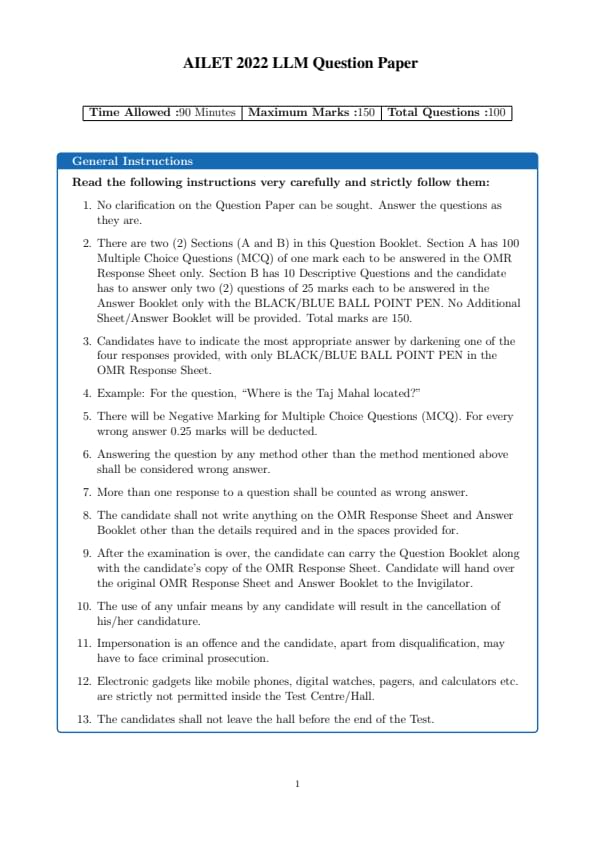

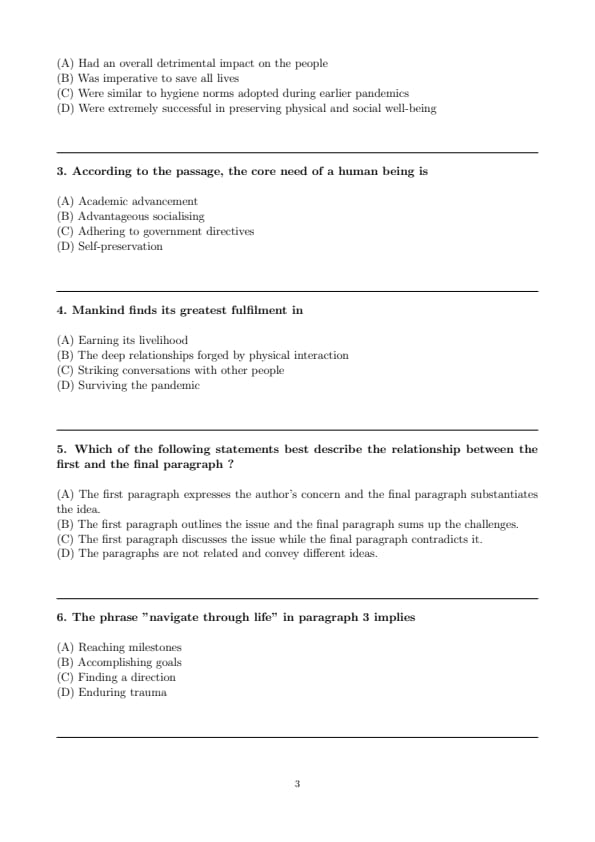



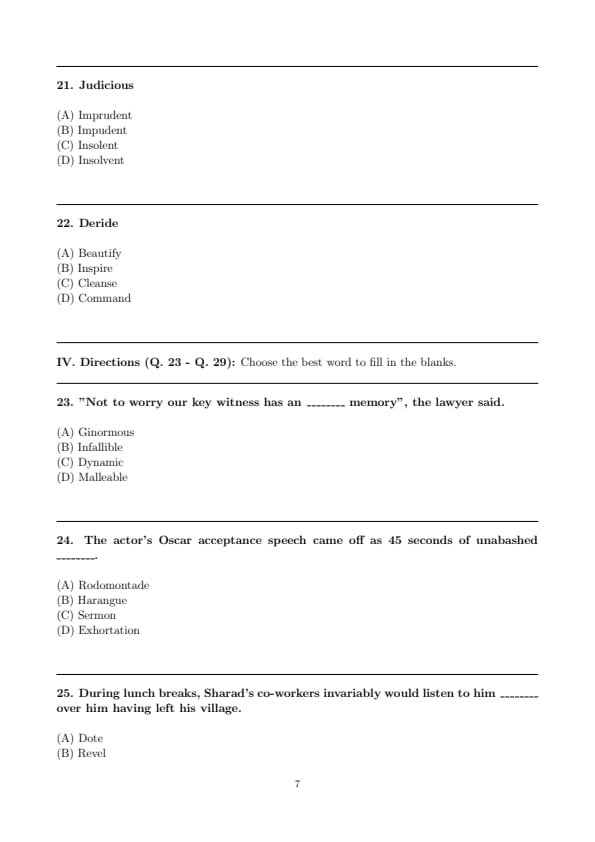
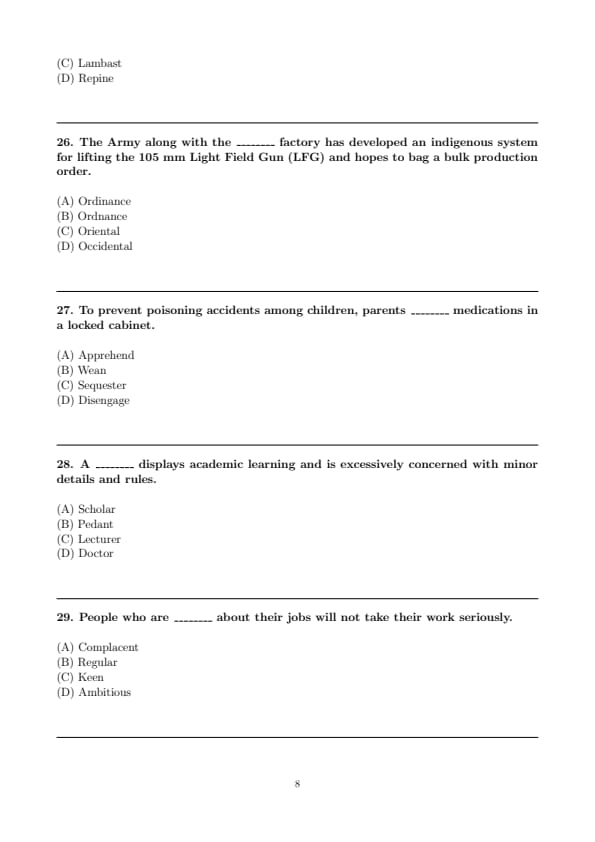

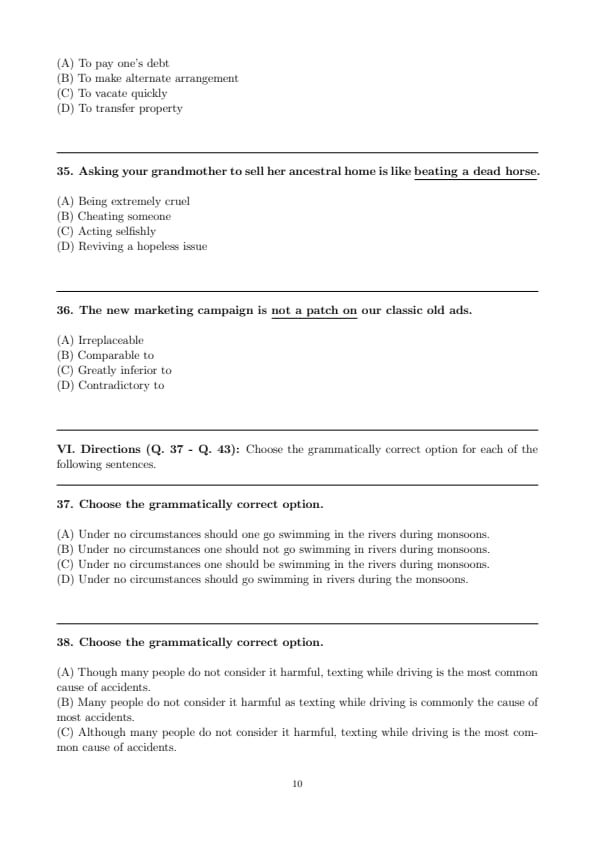



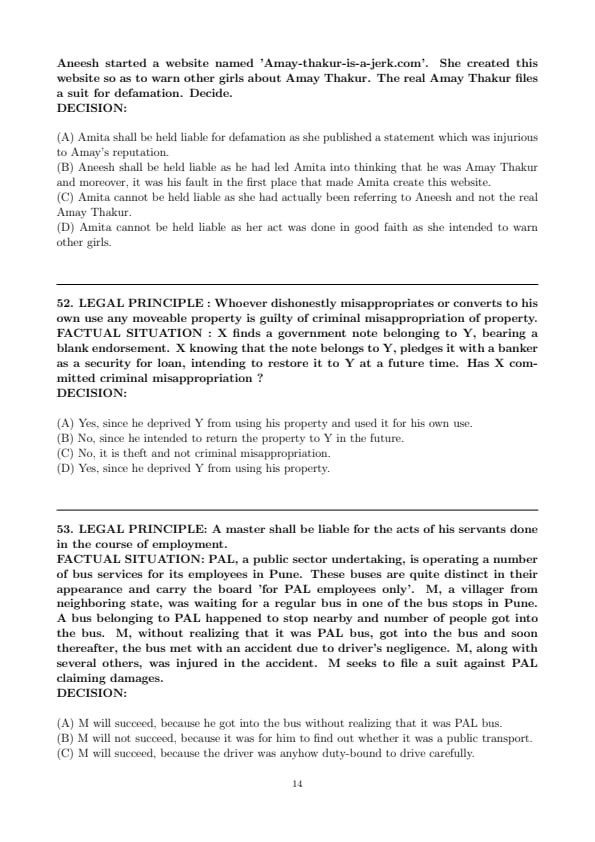
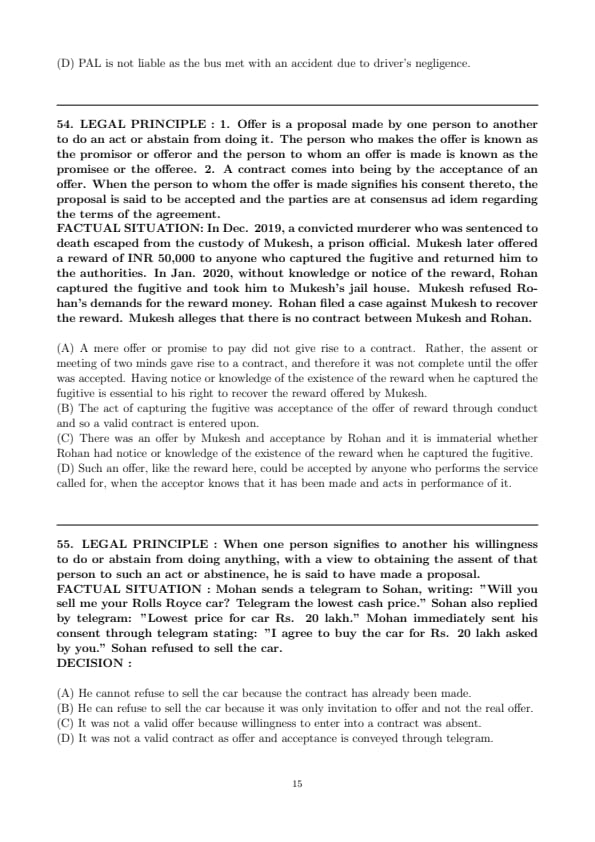
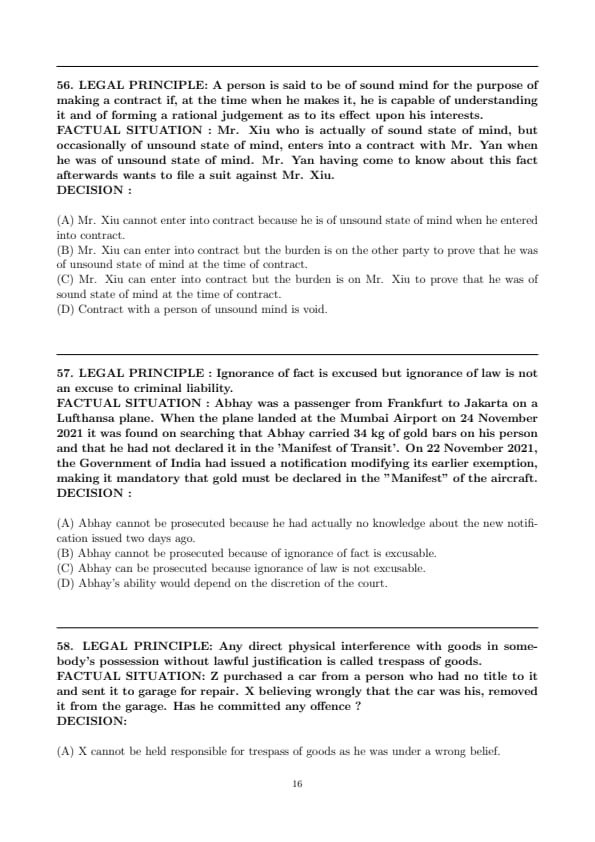
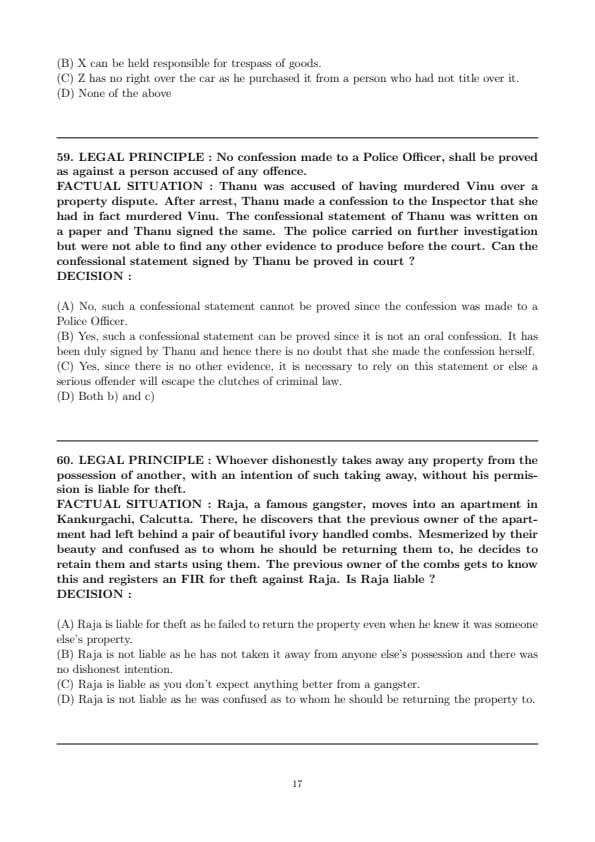

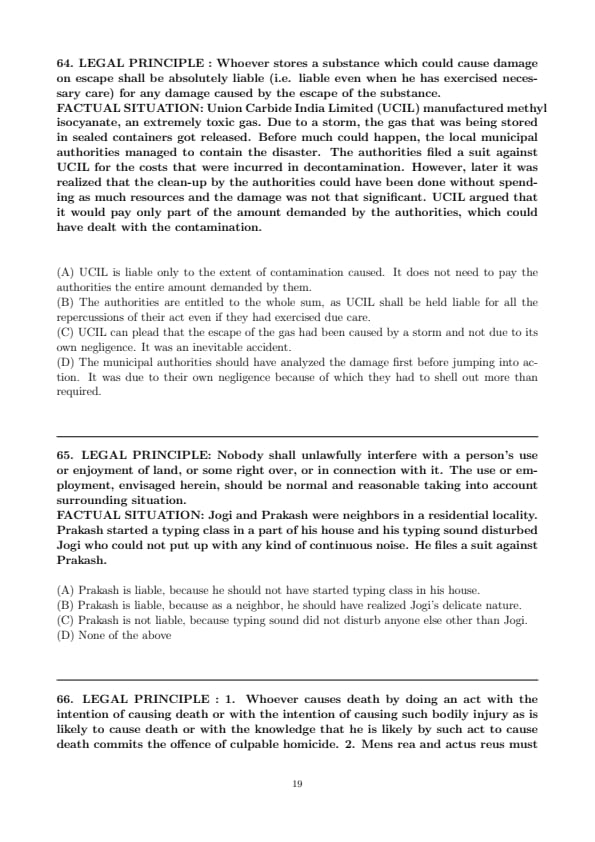

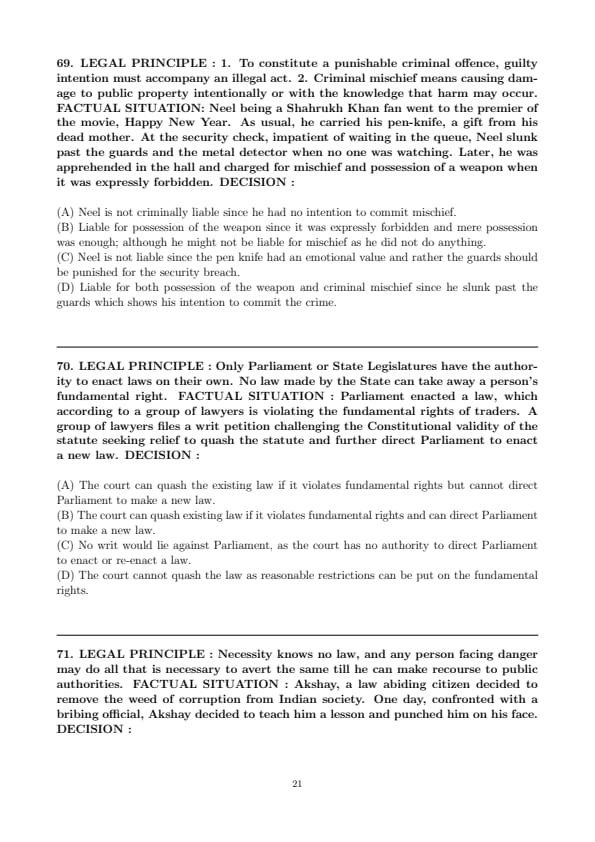
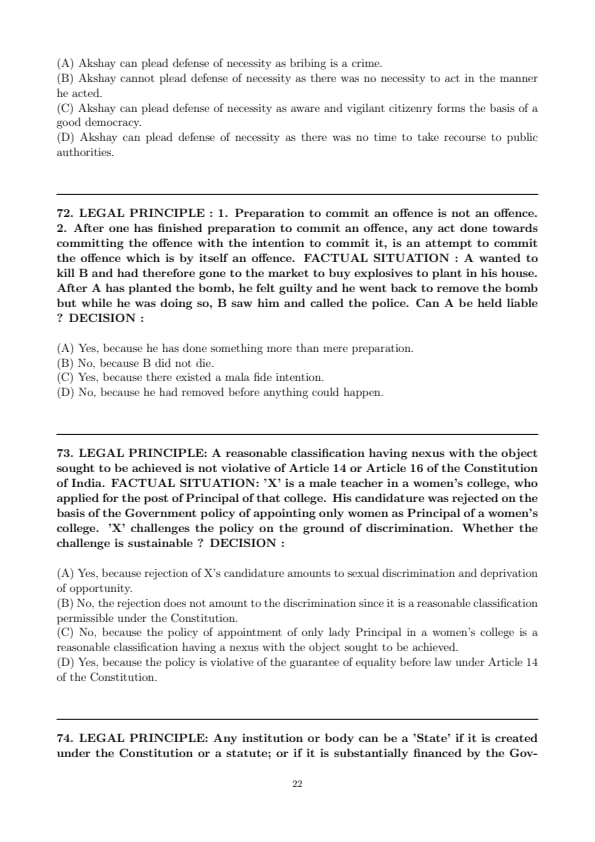
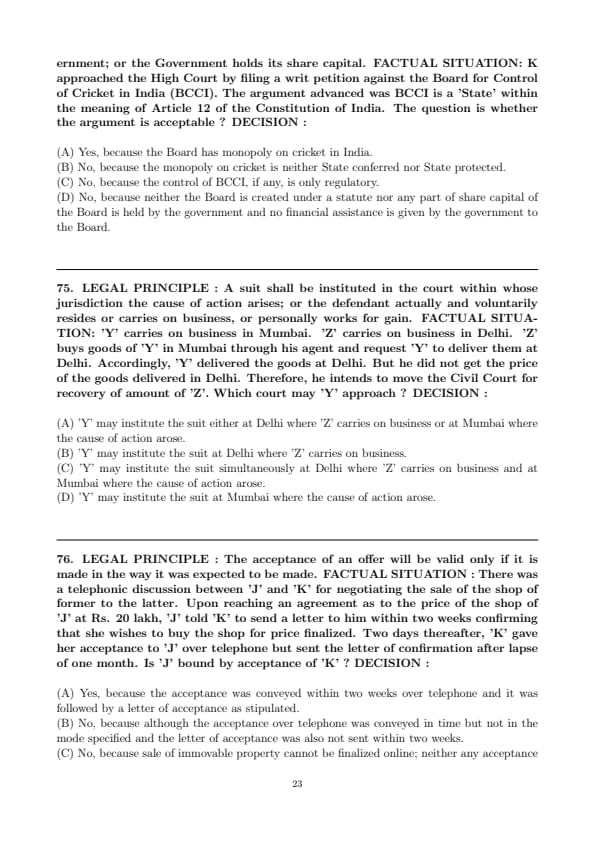
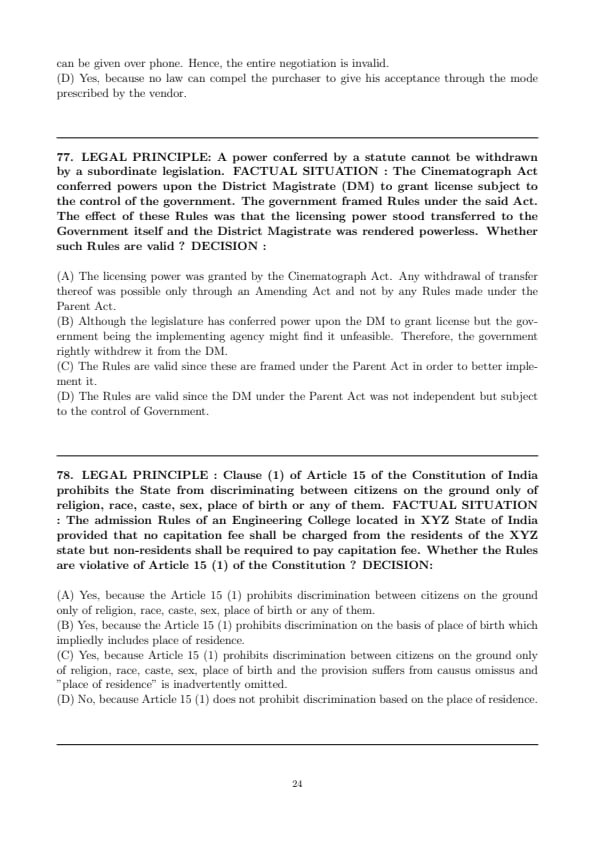
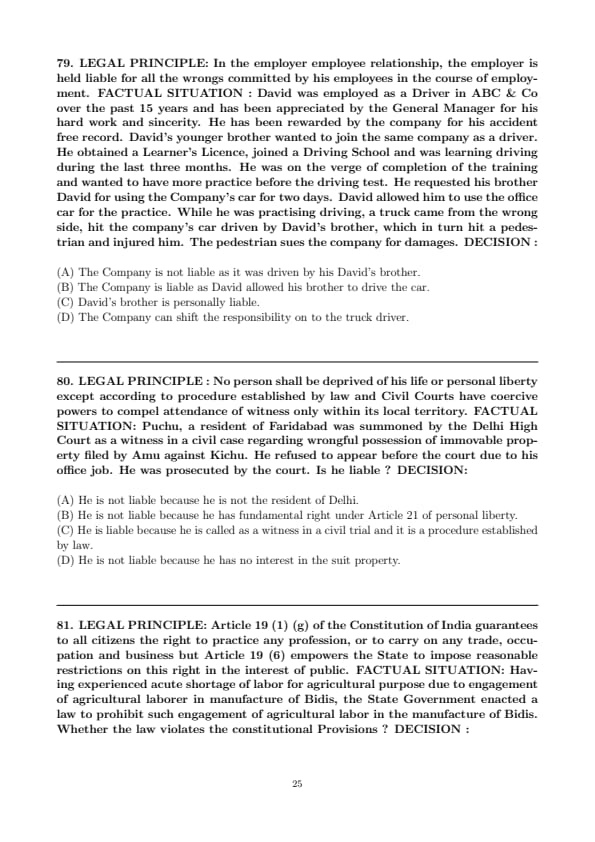

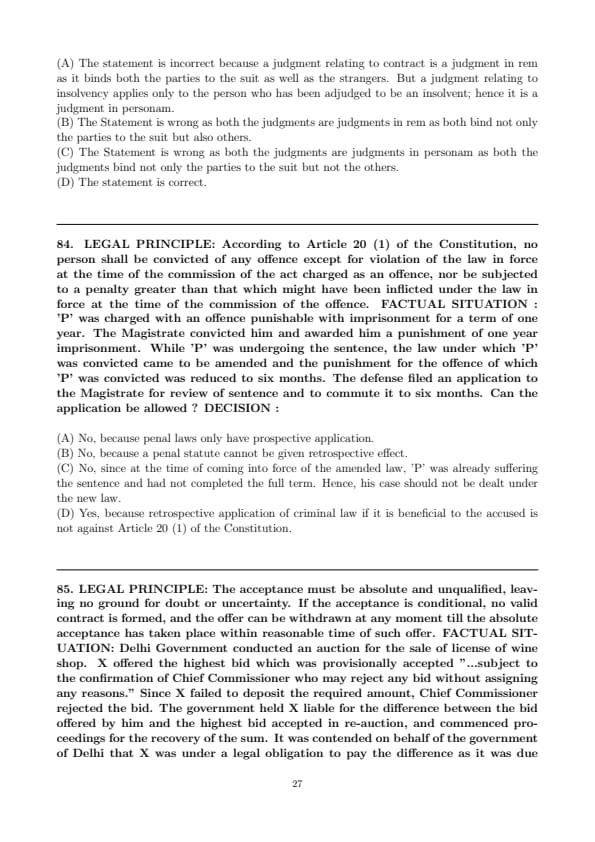

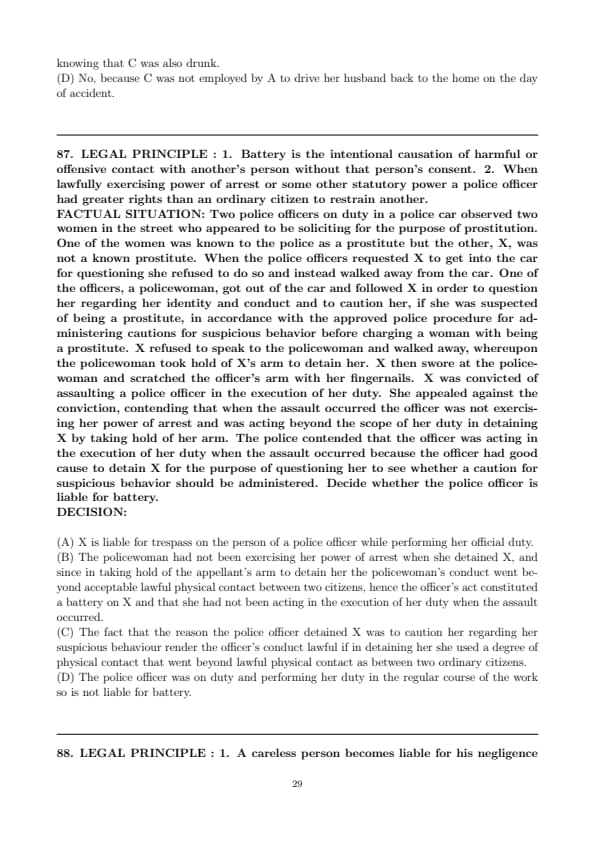

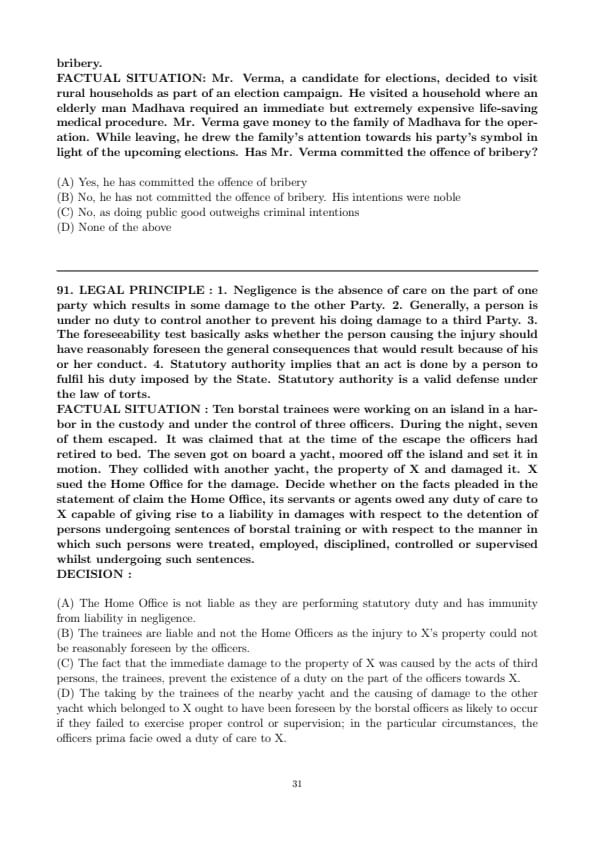
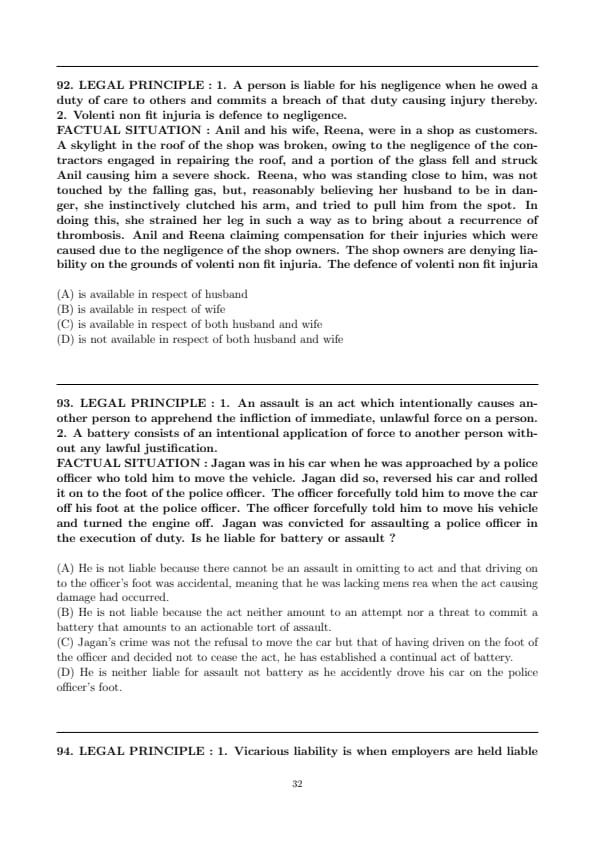


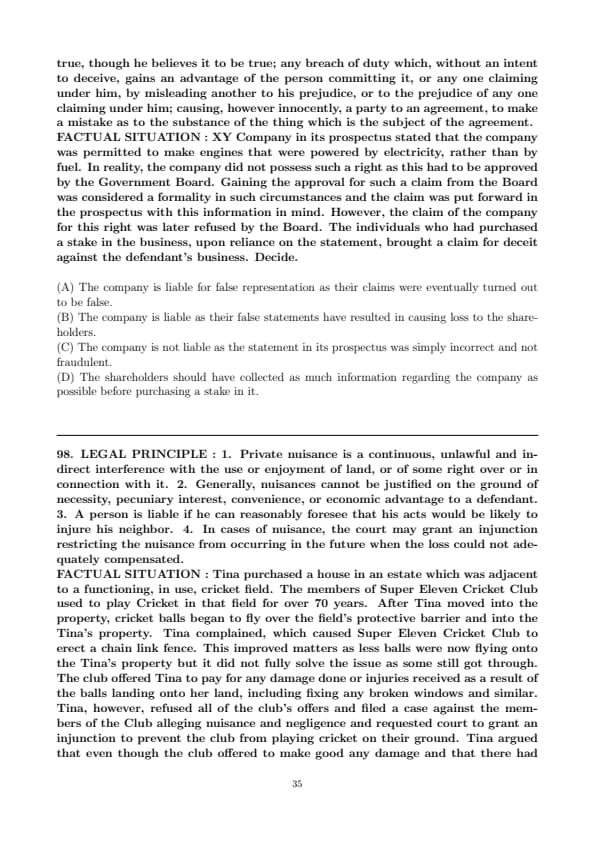
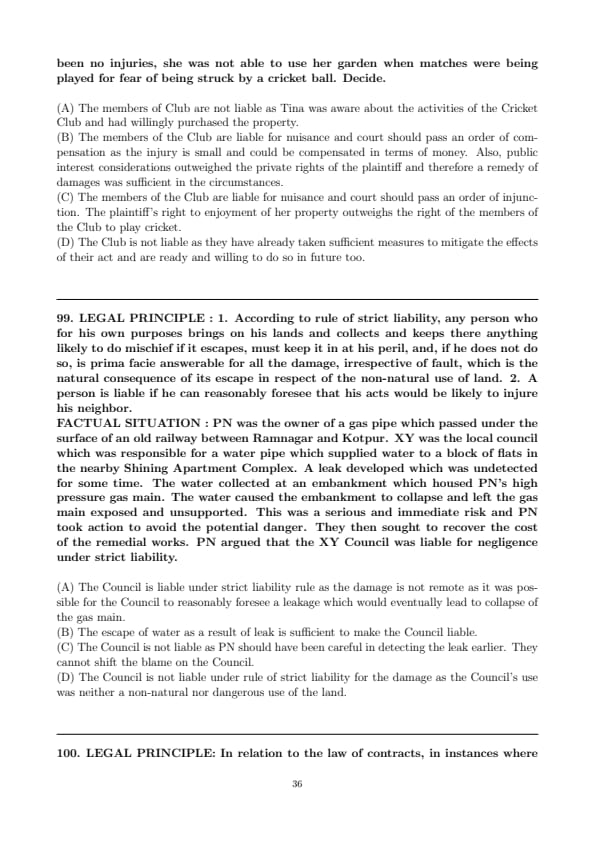
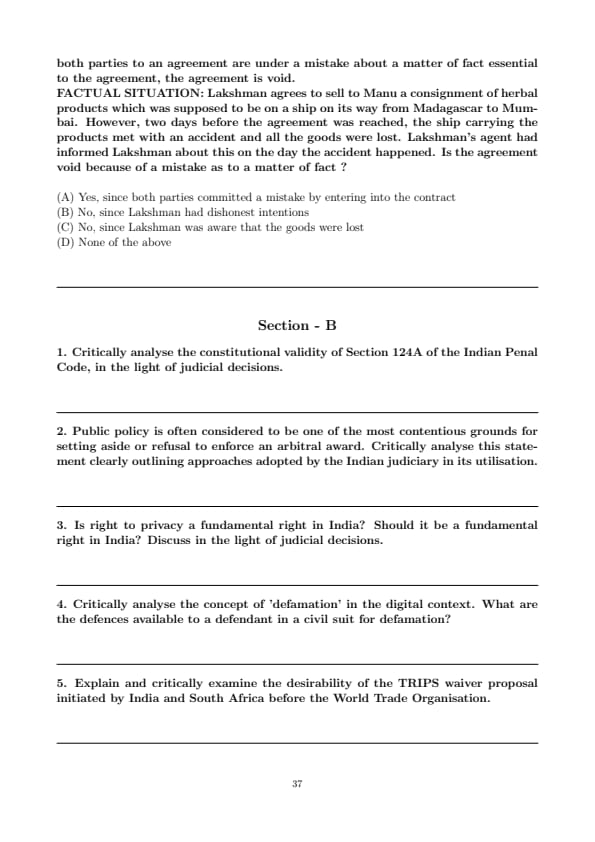




Comments